This trip was not a travel agent trip: we were looking for a destination to meet up where neither I, nor my daughter, had ever been before and that was fairly easy to get to for me and from where she was stationed.
Having said this, the trip, (for me): a flight from Montreal to Vancouver and then a second flight from Vancouver to Bangkok, was a long one!
Disclaimer: I took the trip a year ago, so I could have mixed up some names, temples or buddhas. I apologize in advance.

The “formula” for this trip was a new one for both of us: we chose a private tour, which means we had a guide, driver and private car, all to ourselves. The itinerary had already been decided, so all we had to do was show up in the morning and everything was arranged for us, even meals! Every time a lunch was included, our guide would call the restaurant ahead of time, usually as we were on the way, he would inquire about the menu, relay it to us and then place our order, so that the meal was ready when we showed up! He quickly figured out our tastes so he picked places or suggested things that were different from one day to the next but within our taste palette (spicy but not fiery). He would also often pick up local snacks along the way. The vehicle was a large air conditioned van, it always had a cooler full of water bottles and refreshing wipes. All very self indulgent but ohh so nice!
I was met at the Bangkok airport which went smoothly. I was even able to find long term storage in the terminal for one of my suitcases as I would be continuing on to a colder climate after Thailand. It was early morning in Bangkok so I saw the sun come up as we drove to the hotel. What struck me the most was the number of high-rises and the variety of architectural styles. It could have been any big city in the world. As we got closer to town traffic intensified a bit but it was nothing compared to what we would experience in the days to come. As soon as I got to the hotel, I went to bed…and slept for 24 hours.
By the next morning, I was ready to head out! Today was totally hedonistic, starting with a Thai massage (https://www.dahra-spa.com/) and ending with dinner in a Michelin star restaurant: the KHAO (Ekkamai).
The massage was a bit of a surprise for me. The building was dark and a bit mysterious. We went up several flights of stairs to small alcoves with a mattresses on the floor. After undressing and donning brown kimonos, we were asked if we wanted a hard, medium or light massage. I, not knowing, went for a medium… Ouch! it was rough. I got stretched and pulled and pushed in ways I did not think my body could go. But in the end all was fine. I was told I am not very supple. Ha! who would have thought?
As for the restaurant, it was an interesting introduction to Thai food. The place was bright and airy, the service was efficient, the food and cocktails were colorful and tasty. The whole experience was simpler than I expected of a Michelin starred property but not at all disappointing. It is interesting to note that in Thailand they bring all the dishes to the table at once.

On the way back to the hotel after the massage, our guide took us to the Terminal 21. It is an upscale mall laid out in floors with a country or city themes. The food court is a must to visit. You need to buy a “card” for a set amount and this is what you pay each vendor with. We zoomed by the stores up to the food court, stopping along the way to go to the toilet (a note worthy stop not to be missed!). Rows of stalls each one equipped with a smart toilet, read: water jets, front and back, adjustable temperature and intensity as well as adjustable heated drier! Most of the toilets in Thailand are equipped with a water hose of some kind, but few are this fancy! As for the food court, this is a good place to know as there is an awful lot to choose from, the quality of the food is exceptional, yet the prices are lower than in regular restaurants. We returned there several times to bring food back to our hotel room after busy touring days.
Day three, today we start our discovery of Bangkok in earnest. The market is colorful and filled bushels of flowers and food items that are a mystery to me.
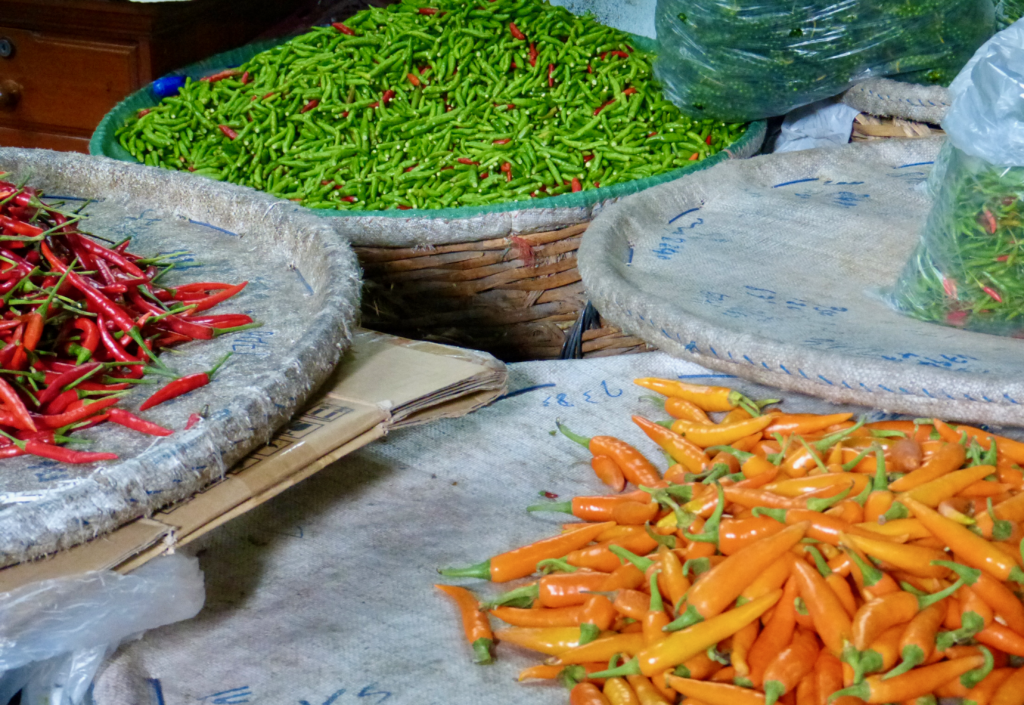

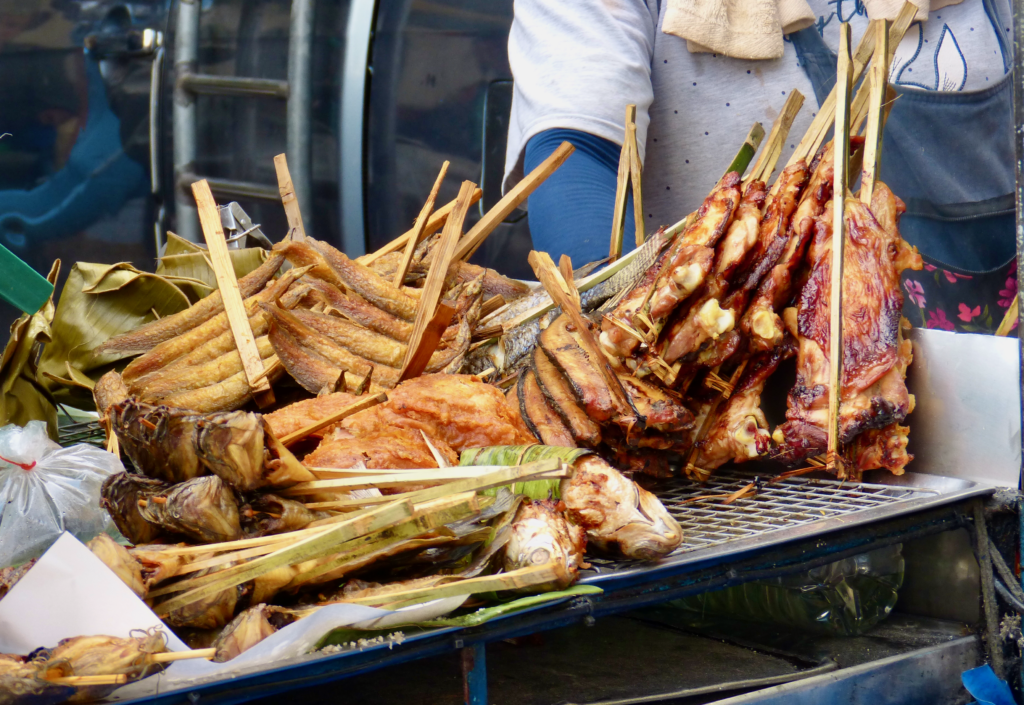
This was our first street food experience…the first of many.
Next is the star of the day: the Grand Palace. This is really an entire city. It is divided into two main zones, which are the Temple of the Emerald Buddha and the royal residence. The latter is divided into three major areas: the Outer Court, the Middle Court, and the Inner Court.
Construction of the palace began in 1782, at the order of King Rama I, the founder of the Chakri, when he moved the capital city from Thonburi to Bangkok. It is still used for official events today. The Grand Palace is made up of numerous buildings, halls, pavilions set around open lawns, gardens and courtyards. The palace was initially built entirely out of wood. Over the next few years the king began replacing wooden structures with masonry, rebuilding the walls, forts, gates, throne halls and royal residences. This rebuilding included the Wat Phra Kaew, close by, which would come to house the Emerald Bouddha and is considered the most important Buddhist temple in Thailand. The buddha is set very high and appears “small” but is in fact 66 inches tall. He has three different costumes depending on the season.
I found these guards fascinating.
In the afternoon we went on a long-tail boat ride through its canals, locally known as Khlongs, to see Thai houses and typical rural life. A word about those boats…They can be noisy and smell of gazoline, but mostly are not easy to get into for someone my size. They are very low in the water therefore quite a bit lower than the dock we embark and disembark from. Furthermore they have low “roofs/sun protector” so you have a rather narrow window to slip through…. having said that, those boat rides were lovely and gave us a different perspective on the life of in Bangkok.
One of the spectacular sites we sailed by is the Wat Arun. It is encrusted with colourful porcelain which makes it sparkle in the sun.
This was supposed to conclude our day but we asked our guide if he could show us something else so he took us to the Wat Pho temple complex directly south of the Grand Palace. It is one of Bangkok’s oldest temples. The temple complex houses the largest collection of Buddha images in Thailand, including a 46 m long reclining Buddha. There are four towers, or phra prand, at each corner of the courtyard around the bot. Each of the towers is tiled with marble and contains four Khmer-style statues which are the guardian divinities of the Four Cardinal Points
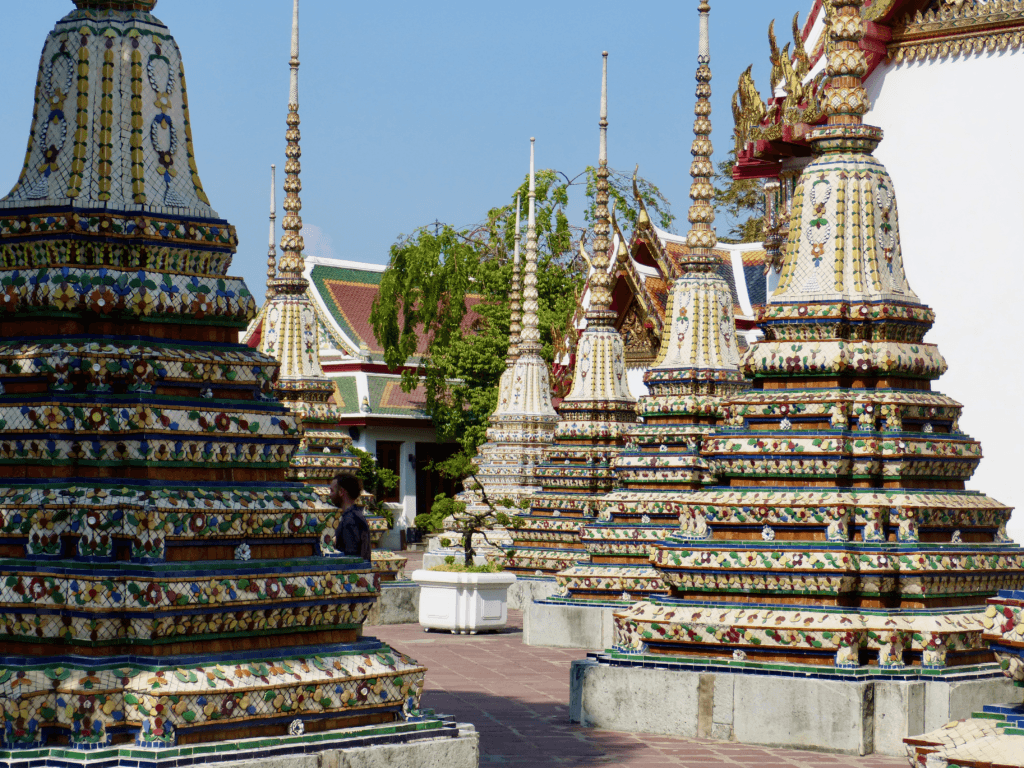
The image of the reclining Buddha represents the entry of Buddha int Nirvana and the end of all reincarnations. The posture of the image is referred to as sihasaiyas, the posture of a sleeping or reclining lion. The figure is 15 m high and 46 m long, and it is one of the largest Buddha statues in Thailand. The figure has a brick core, which was modelled and shaped with plaster, then gilded. The soles of the feet of the Buddha are 3 m high and 4.5 m long, and inlaid with mother-of-pearl. At the center of each foot is a circle representing a chakra or ‘energy point’. There are 108 bronze bowls in the corridor representing the 108 auspicious characters of Buddha.
Wat Pho is also Thailand’s first university and remains the national headquarters and the center of education of traditional Thai medicine and massage to this day.
Day four, was more nature oriented with visits to horticultural properties. We again boarded a small boat.
The orchid farm was between crops so did not have a lot to show, but the lotus farm was spectacular.
The Lotus flower, also known as Nelumbo Nucifera, comes in a few different colors including pink, white, blue, and red. It has many layers that get folded back when used in arrangements. The lotus is the national flower of India and Vietnam. It is very symbolic because it generally grows in muddy shallow water and blooms into a beautifully symmetrical flower. The lotus flower in Thailand is given as an offering to the Buddha in temples all across the country. We were shown how to “prepare” the flowers for display, by turning back the outer petals. It is harder than it looks.
Waterlilies grow alongside the lotus and offer explosions of colour.
On the morning of day 5, we head 80 km outside Bangkok to visit the train market. The Maeklong Railway became famous for its route through the Maeklong Railway Market, nicknamed “umbrella pulldown market”. It is one of the largest fresh seafood markets in Thailand, and is centered on the track. Whenever a train approaches, the awnings and shop fronts are moved back from the rails, to be replaced once the train has passed. There is a thrill every time wondering if everyone and everything will have been pulled out of the way in time. But the real attraction, in my mind, is away from the train, in the indoor stalls holding the fish market. This is was a sight to behold. The only comparable fish market I have ever seen was in Zanzibar.
Next we sail over to the Damnoen Saduak Floating Market. It is colorful and entertaining but feels touristy. We did have lunch there but did not buy anything else.
After that nice picnic we hit the road again, this time towards Kanchanaburi where the Khwae Noi and Khwae Yai Rivers meet to form the Mae Klong River. This is where the famous “Bridge over the River Kwai”, is located. It played an important part in the Second World War and was made famous by the novel Le Pont de la rivière Kwaï by the French novelist Pierre Boulle in 1952 and a film made from the novel. It is a beautiful area despite the sad history.
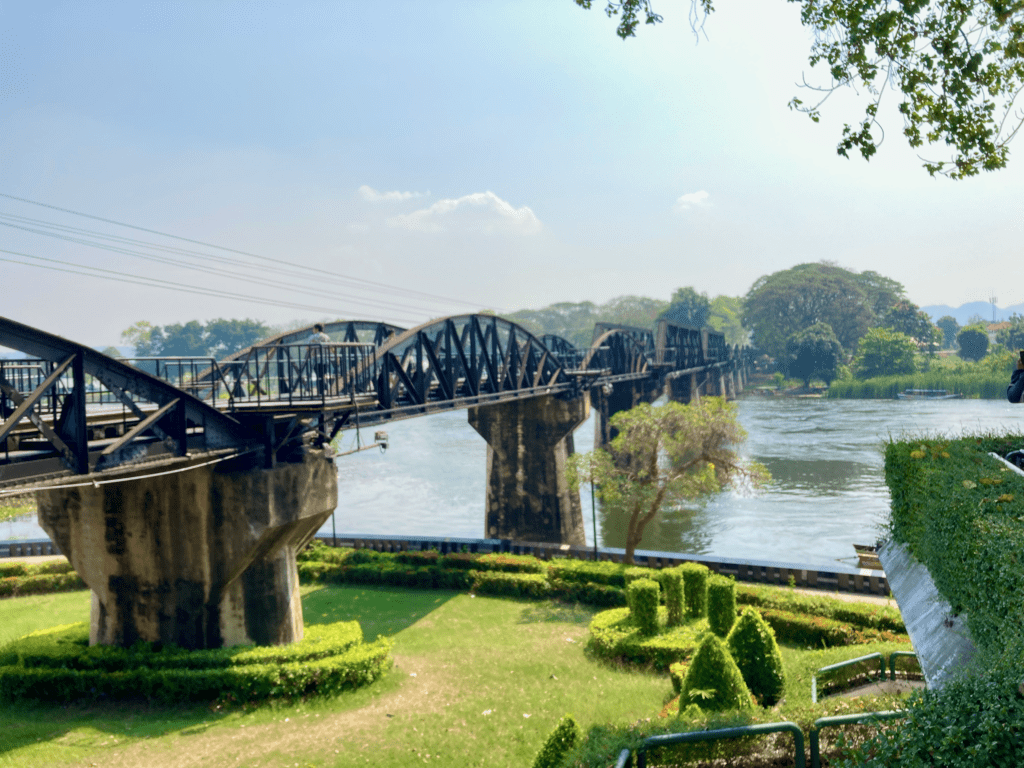

Our hotel was right by the river, as was their outdoor restaurant where they served this lovely stuffed pineapple.
The next day (day 6), I missed the activity but my daughter went to the Erawan national park and falls, and climbed all the way to the top.


The following day (day 7), we head out to Ayutthaya, the former capital of Thailand. On the way we stop at the Bang Pa-In Royal Palace, also known as the Summer Palace, built in 1632. It was later restored in the mid-19th century. It is a lovely complex with fountains and greenery, it is very refreshing.
Once in Ayutthaya we stop at Wat Phra Sri Sanphet (Temple of the Holy, Splendid Omniscient), the largest and holiest temple on the site of the old Royal Palace in Thailand’s ancient capital.
One of the things that enchanted me the most in Thailand were the bird songs. Everywhere we went, even in Bangkok, we could hear lovely bird sounds. It was hard to see them, even more so to photograph them, but here are a few attempts.
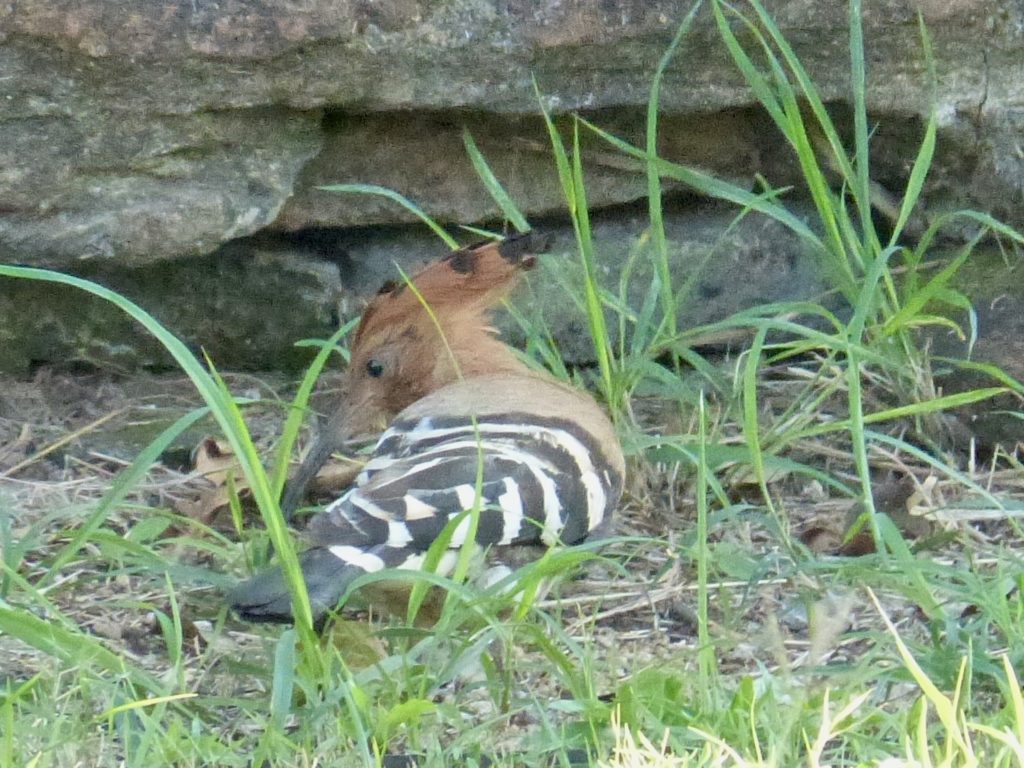
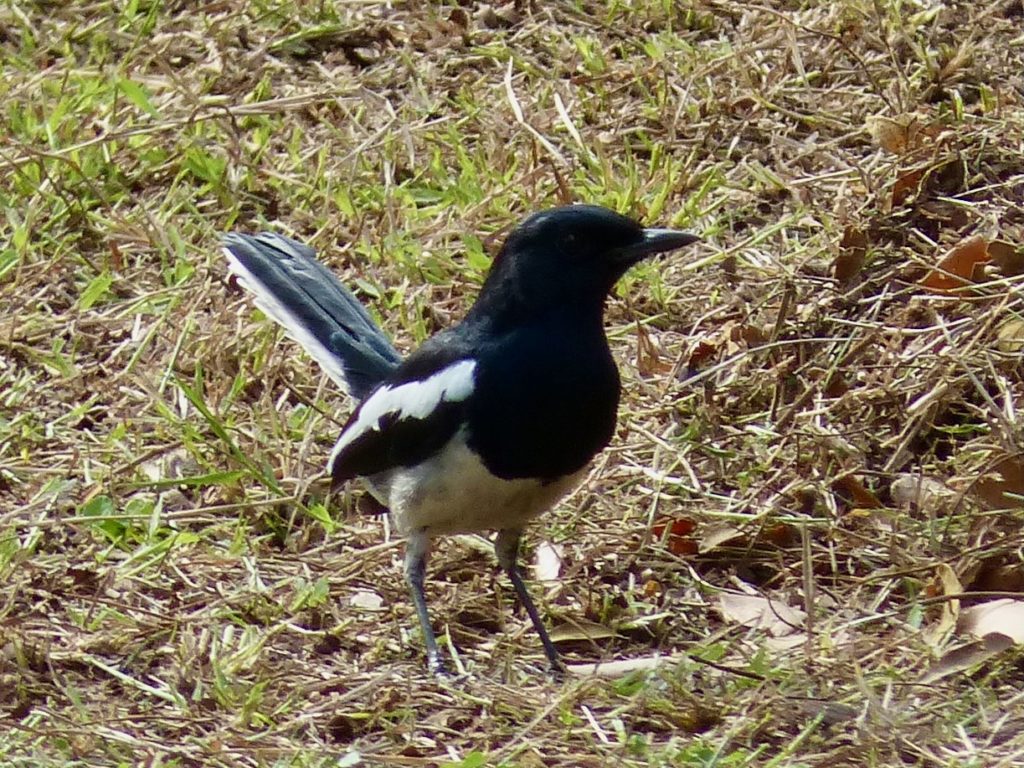

Wat Mongkhon Bophit, former royal temple, is an ‘active’ temple compound, Interestingly lies adjacent to Wat Phra Si Sanphet, and therefore both the ruins of Wat Phra Si Sanphet and the more contemporary Wat Mongkhon Bophit can be visited the same morning or afternoon. The main feature at Wat Mongkhon Bophit is the large bronze (gilded) Buddha image, named Phra Mongkhon Bophit, which is close to 17 meters high.
Wat Maha That one of the 10 royal temples of the highest class, it is one of the oldest and most significant temples in the history of Ayutthaya as it housed the Buddha’s holy relic.

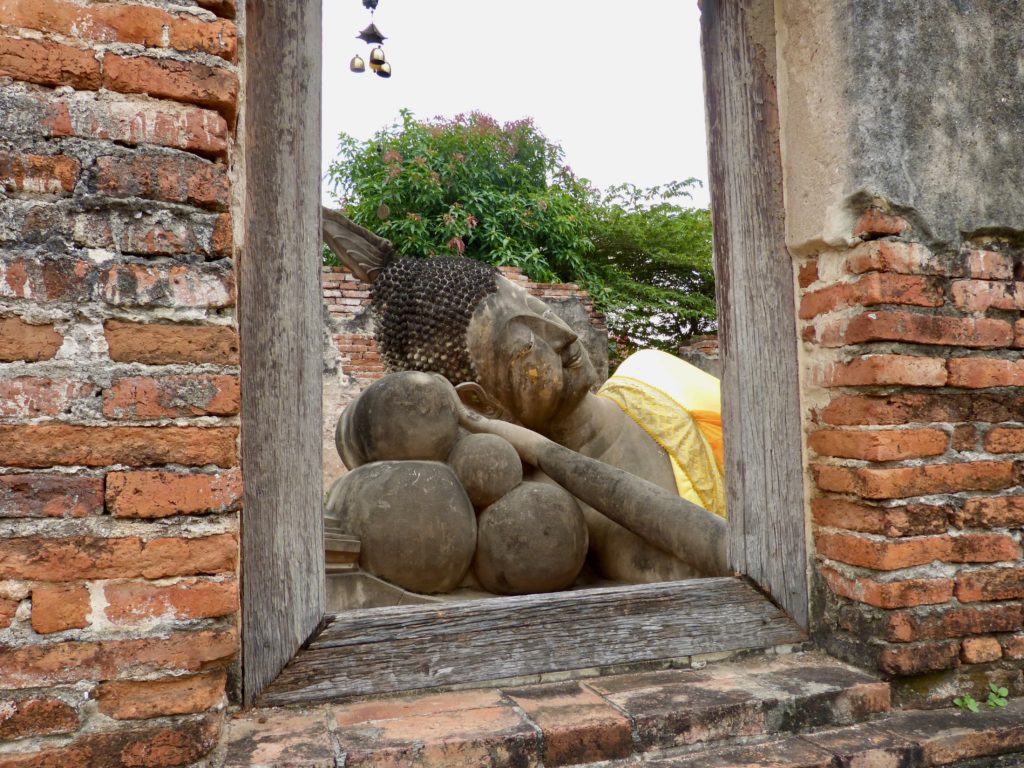
The next day (day 8) we hit the road again, this time direction Sukhothai. Along the way we stopped at Wat Kai, which is part hell temple, part monkey temple.




This is where we were shown a fig tree, it has become known as the bodhi tree because the Buddha reached enlightenment (bodhi) after meditating beneath one such tree for 49 days. The fruit/ flower of the bodhi tree reminds me of the carnivorous plant.
Once in Sukhothai, we visited the Wat Sorasak, a small temple located inside the old walled town. The chedi is a good example of the “chedi surrounded by elephants”, of which many were built during the Sukhothai era. The attractive bell shaped chedi stands on a low square brick base. Protruding out of the base are the bodies of 24 elephant statues that seem to carry the structure of the chedi on their backs. Both the chedi and elephants are made of brick covered with stucco.
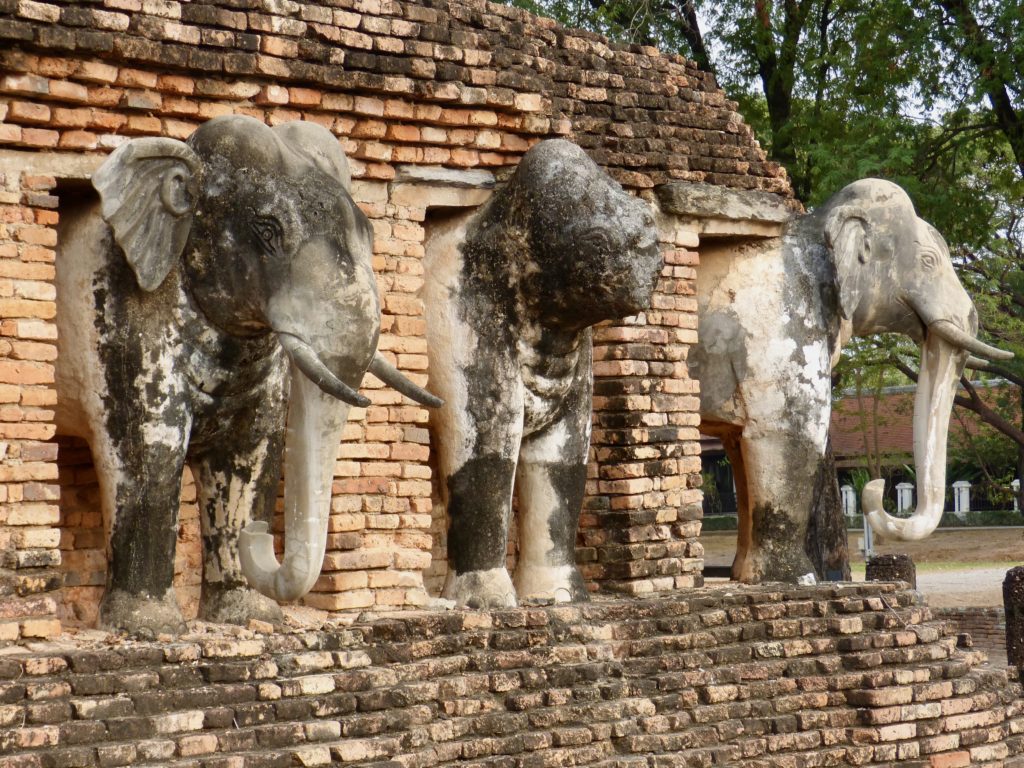

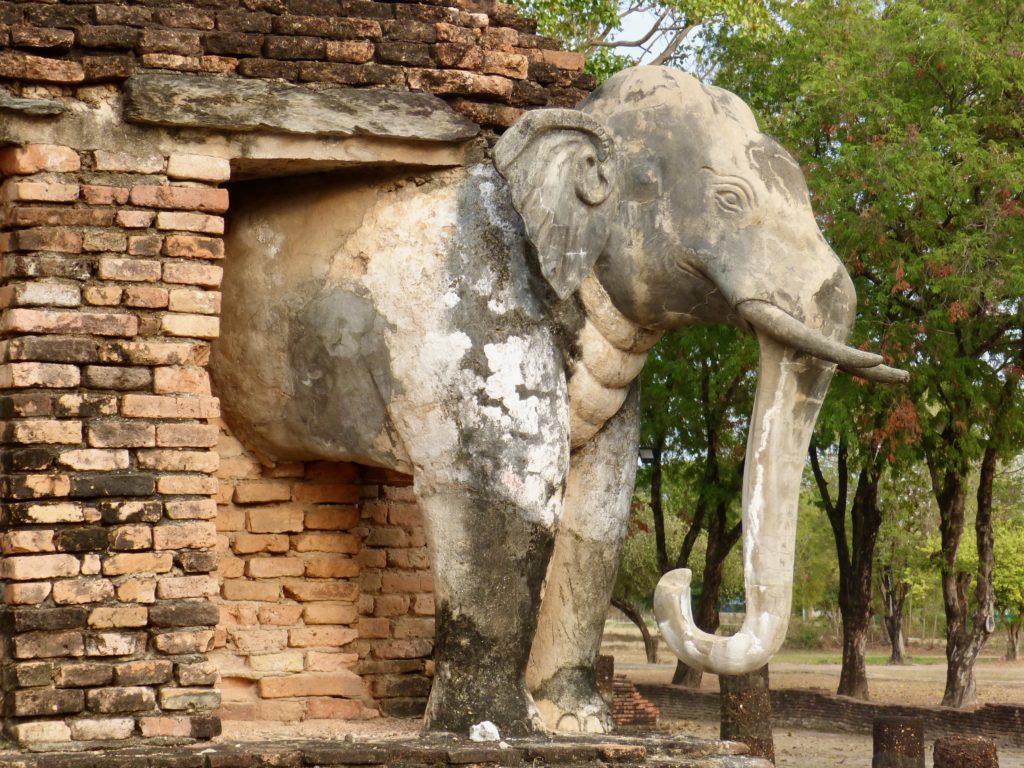
Having arrived in Sukhothai the night before we were ready for a big day of touring. First a bit of history, Sukhothai is the capital of the first Thai kingdom which freed itself from the Khmer Empire of Angkor Wat. It was founded in 12381. In the 14th century, at its peak during the reign of Ramkhamhaeng, Sukothai is said to have been home to at least 180 temples and perhaps, by inference, up to 300,000 inhabitants. It gradually fell into neglect at the end of the 15th century or the beginning of the 16th century. Sukhothai Historical Park covers the ruins of Sukhothai, literally “dawn of happiness”. It is a huge (2 km by 1,6 km), so renting bicycles was a smart way to visit it. This is the one we visited first.
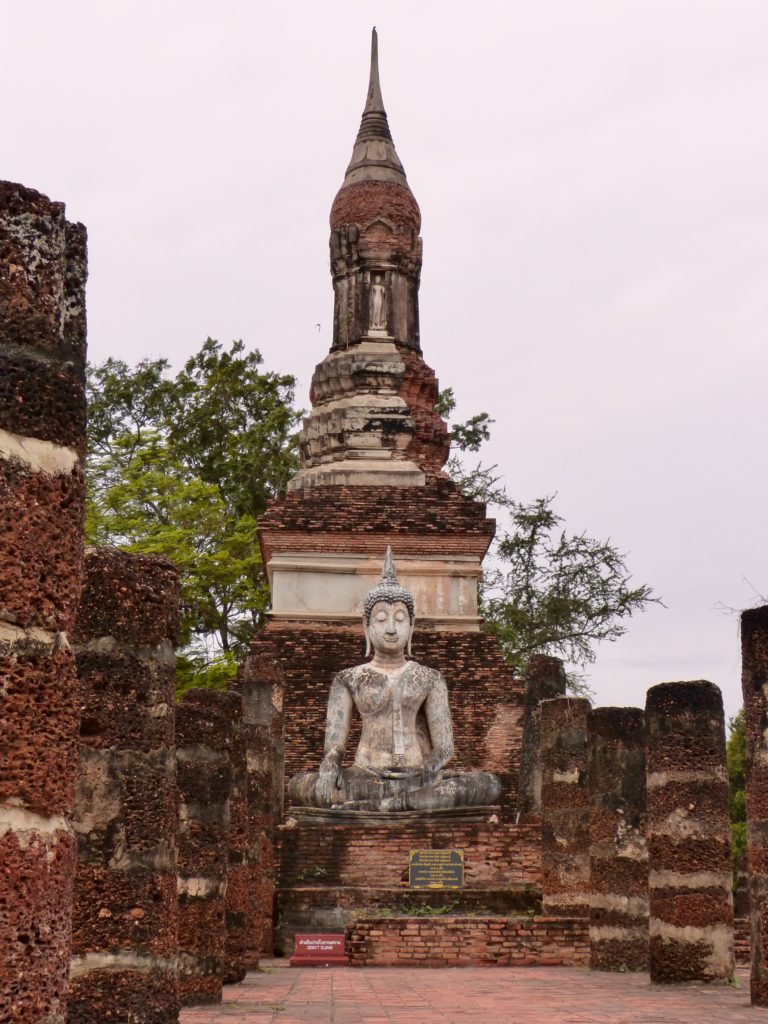
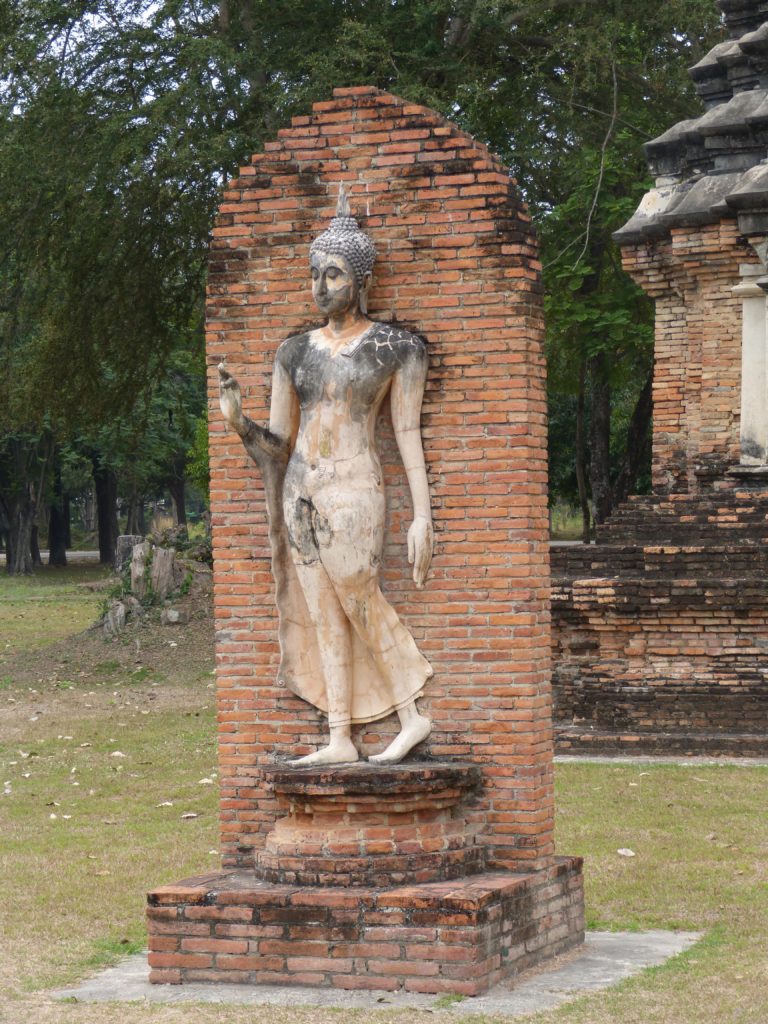
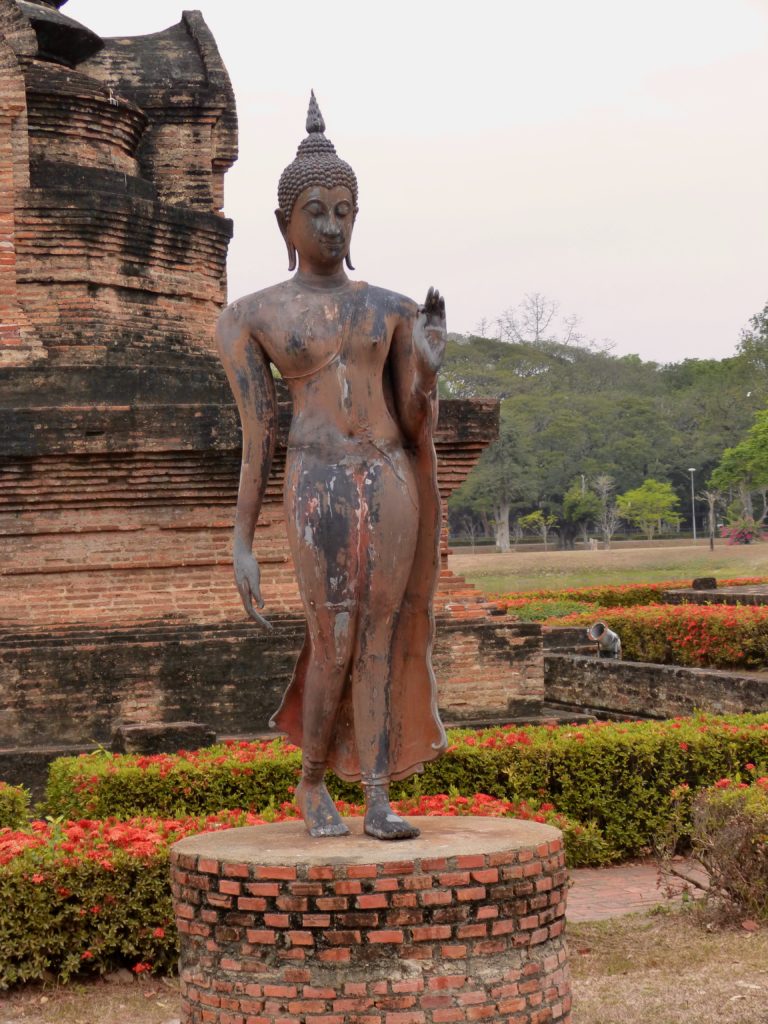
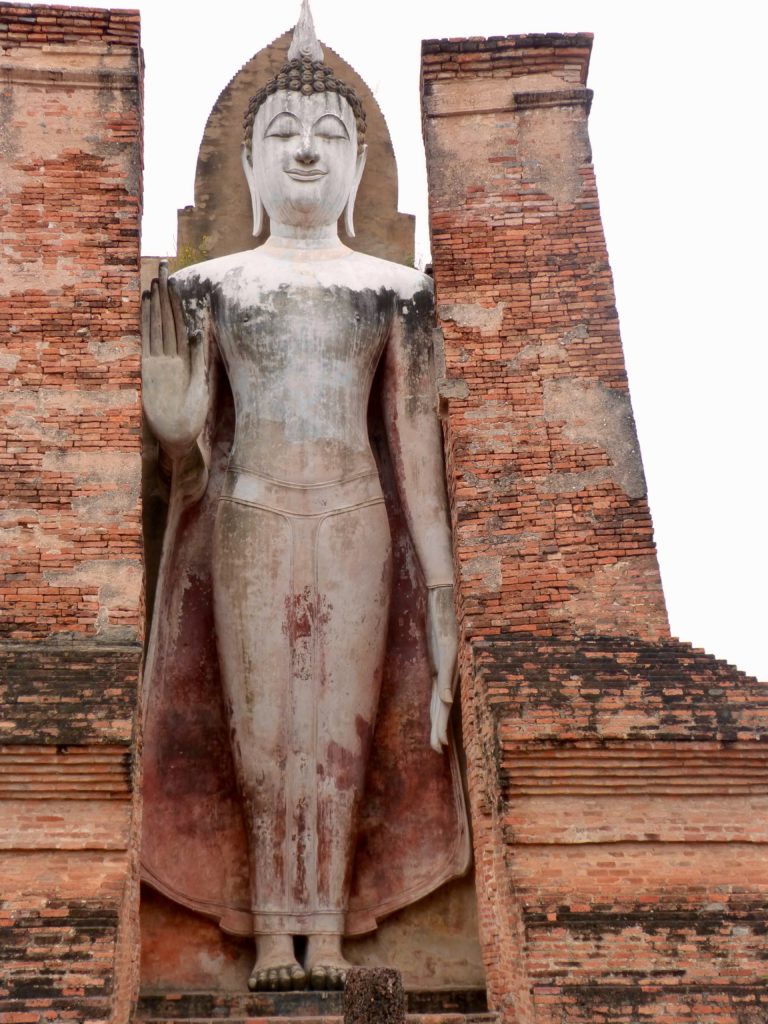
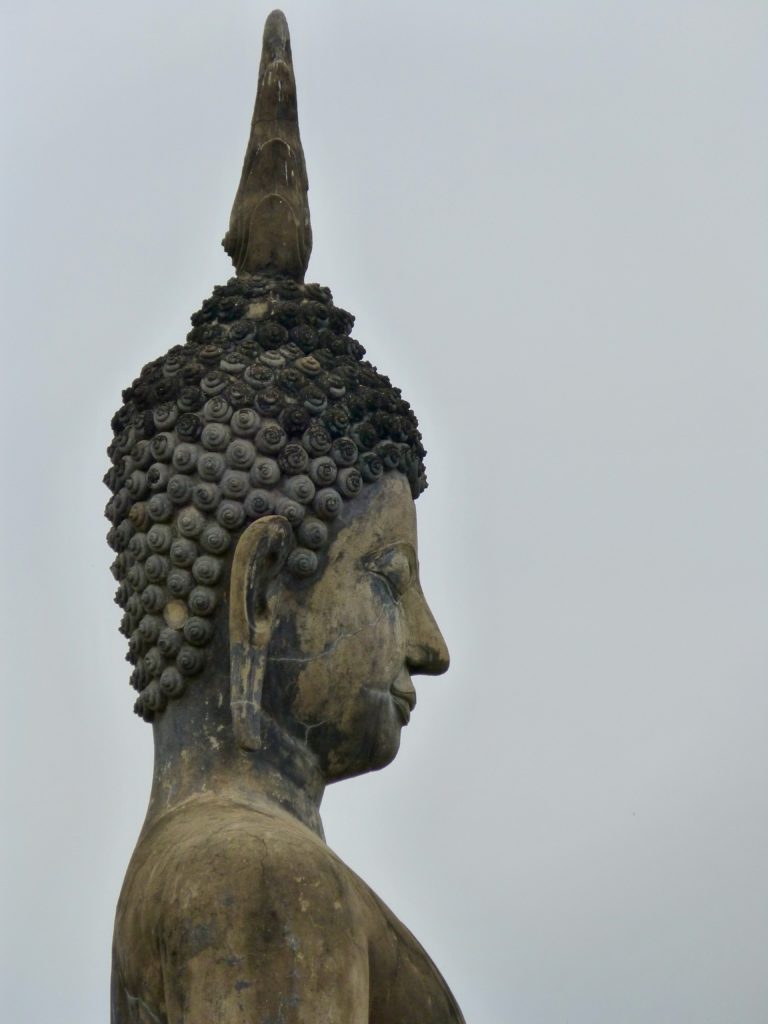
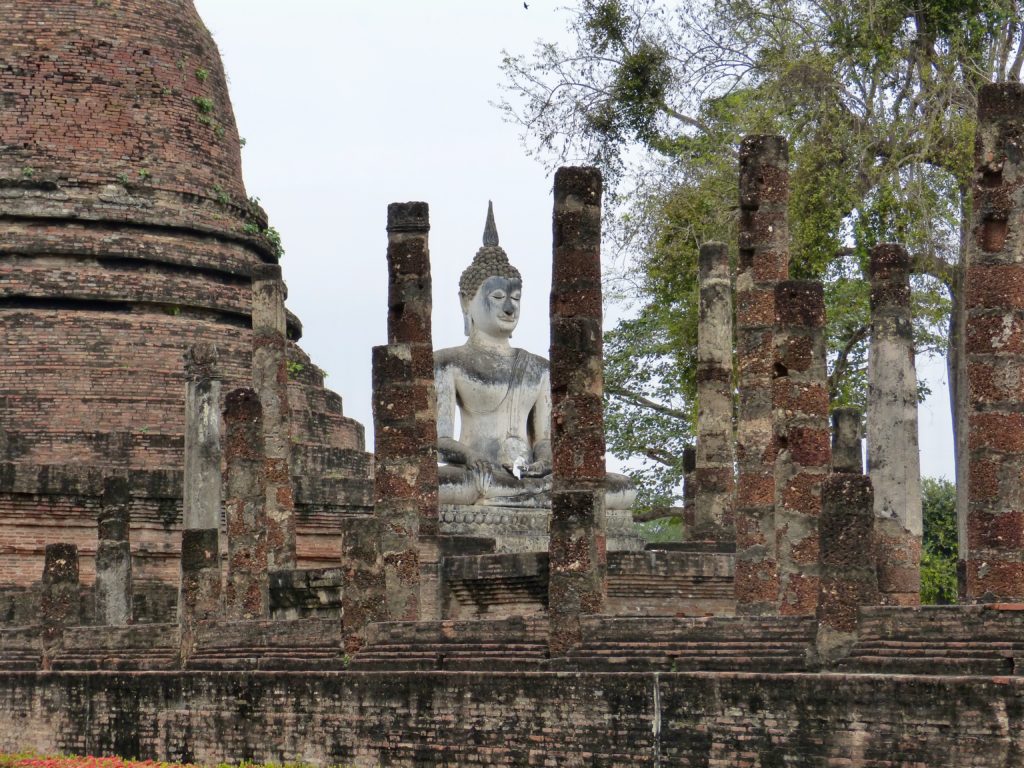
Next we crossed over to the Sri Satchanalai Historical park. The Wat Chedi Chet Thaeo means the temple of seven rows of stupa, housing the remains of 33 stupas within the Sri Satchanalai Historical Park.
It is good to know that Stupas (also called Chedis in Thailand) are structures containing relics – used as a place of meditation.
The 33 stupas can be separated into three main categories according to their style.
The first category includes those whose final point takes the shape of a lotus bud, one of the singularities of the so-called Sukhothai style.
The second category corresponds to the Prasat type, that is to say those with a massive appearance and equipped with niches or multiple points.
The last type of stupa corresponds to those having the appearance of a bell. Few in number, some retain some stucco bas-reliefs.



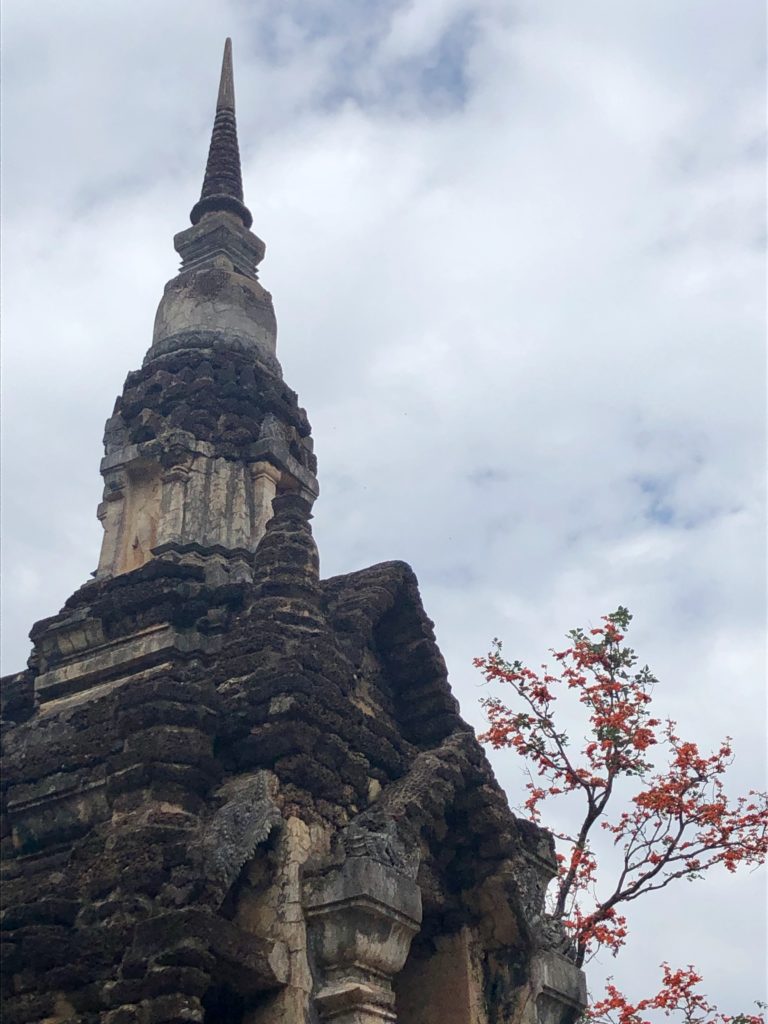


We also visited Wat Chang Lom, the “Temple Surrounded by Elephants”.
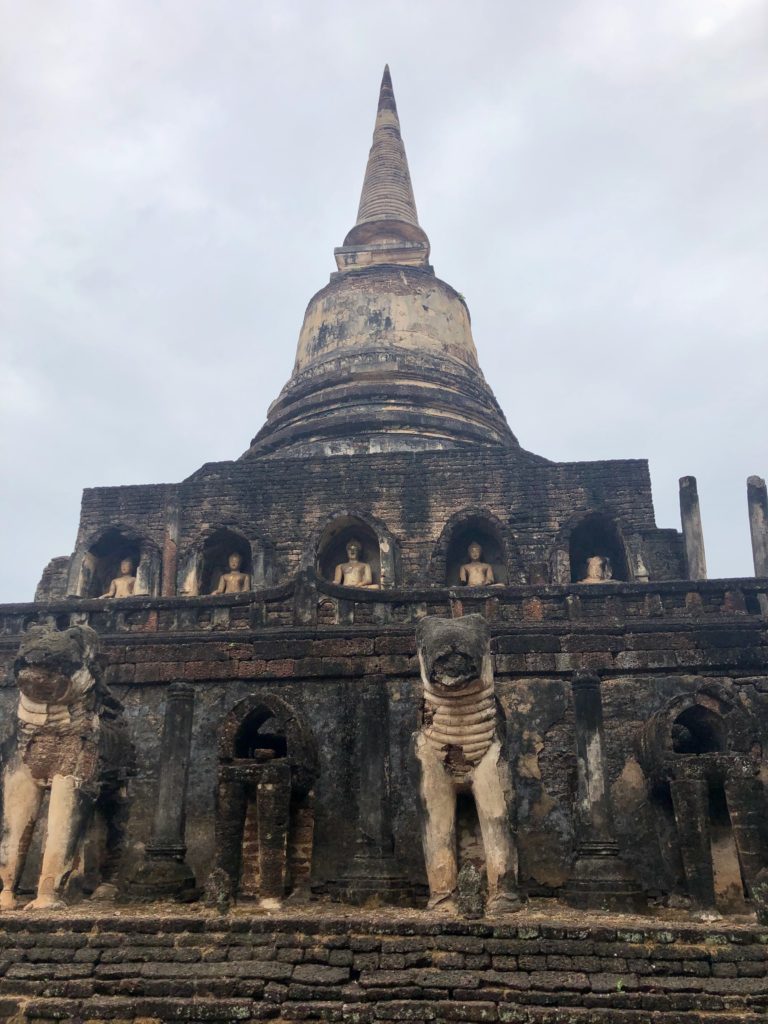

Our hotel was located in a very lush environment, it was very refreshing. We had to cross a little swinging bridge to get to our bungalow…luckily someone carried our suitcases…



The next morning I got up before sunrise, rode a tuktuk to go witness the procession of monks coming out of their monastery just before dawn, and walking across a bridge to collect gifs from worshipers. Those saffron colored robes are so bright!



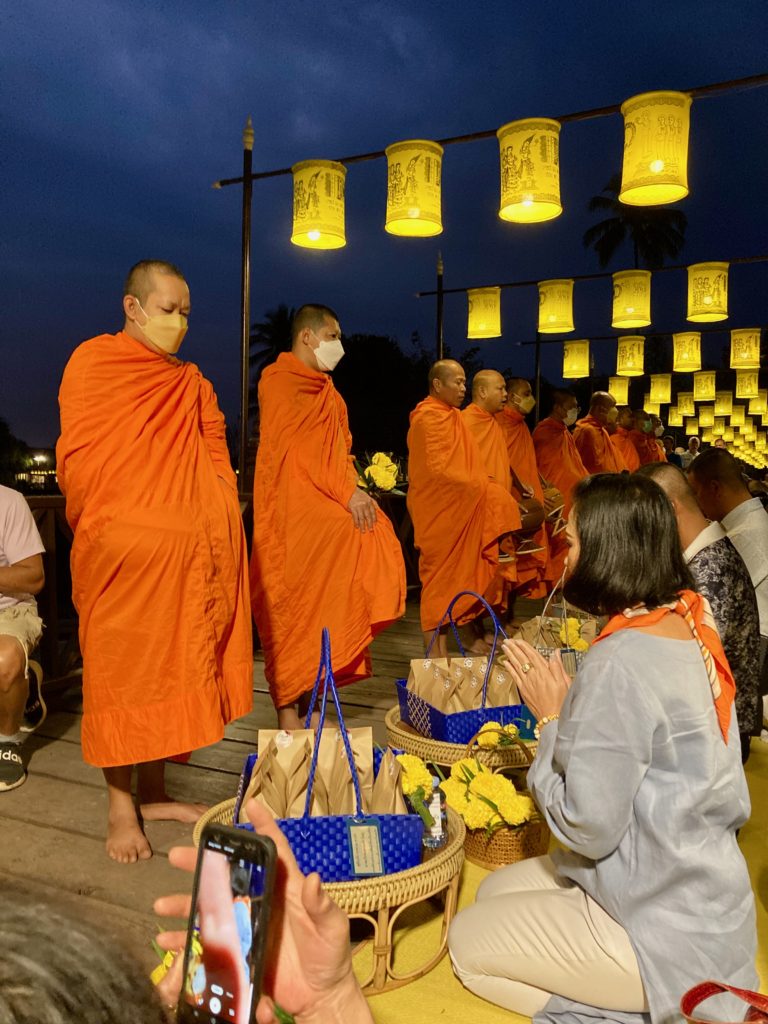


The next day (day 10) we got back on the road, this time headed for Chiang Rai. We stopped along the way in Lampang for a traditional horse drawn carriage ride before visiting the temple of Wat Phra That Lampang Luang





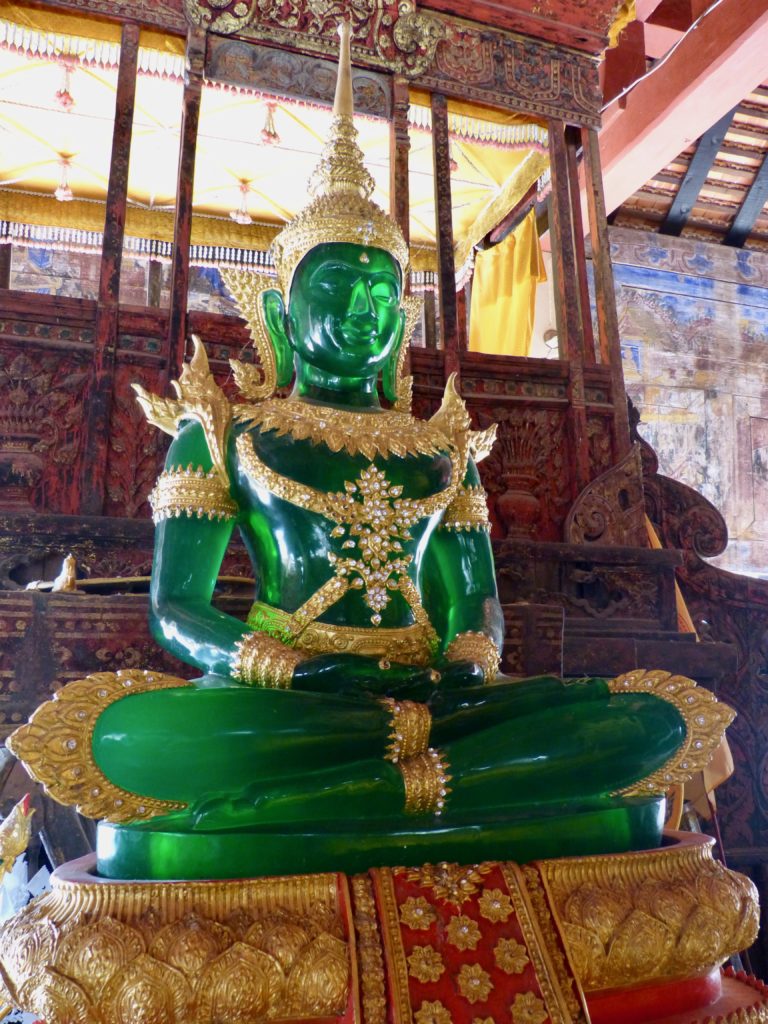
While the Wat Phra That Lampang Luang is a buddhist temple in the Lanna style, the Wat Si Rong Muang is in the Shan-style.

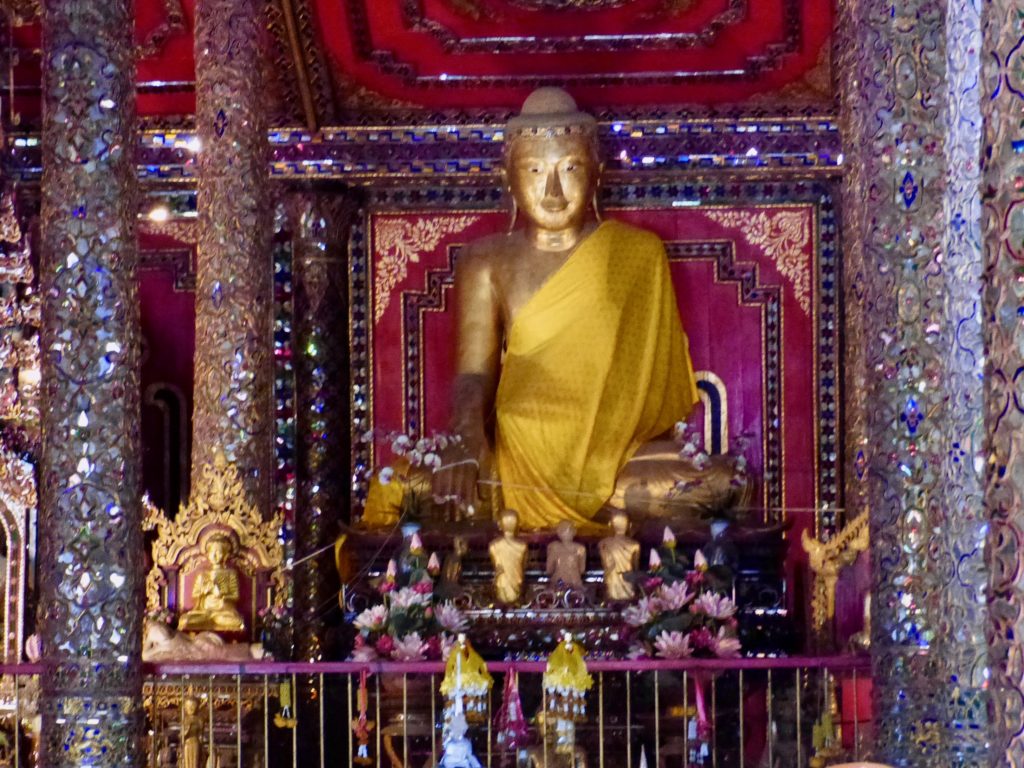
Our next stop is at the Wat Phra Kaeo Don Tao literally “monastery of the Emerald Buddha on the water jar knoll”. It is the principal buddhist temple in Lampang, with a mix of Mon, Shan, Burmese and Lanna styles

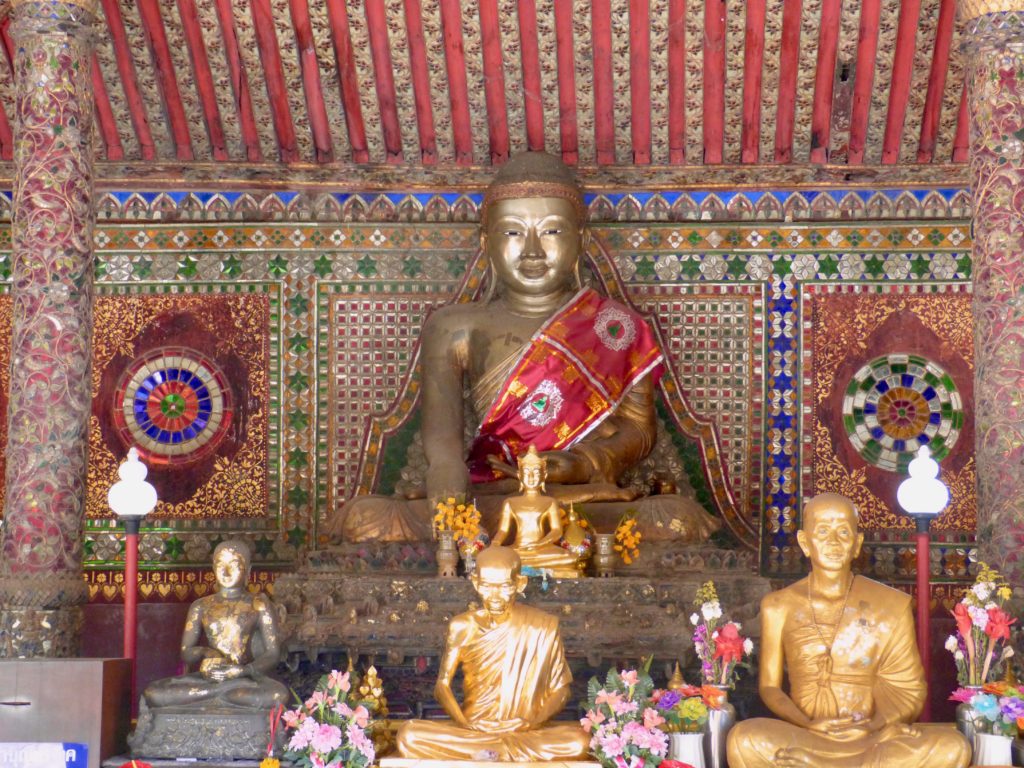

Also in the region of Chiang Rai we visited the Wat Rong Sua Ten or Blue Temple. The temple’s construction was completed in 2016. Its final design was realized by local artist Phuttha Kabkaew, who learned from Chalermchai Kositpipat (White Temple). It follows in the unconventional “neo-traditional” style of Buddhist art employing lavishly ornamented sculptures and psychedelic visual imagery.
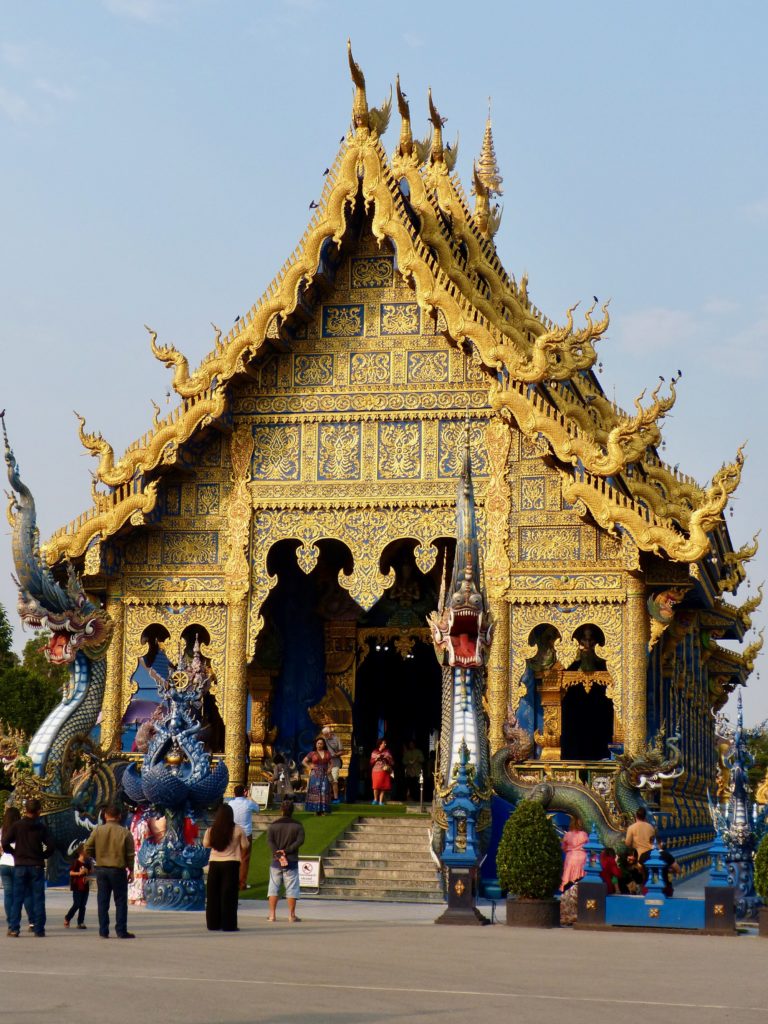

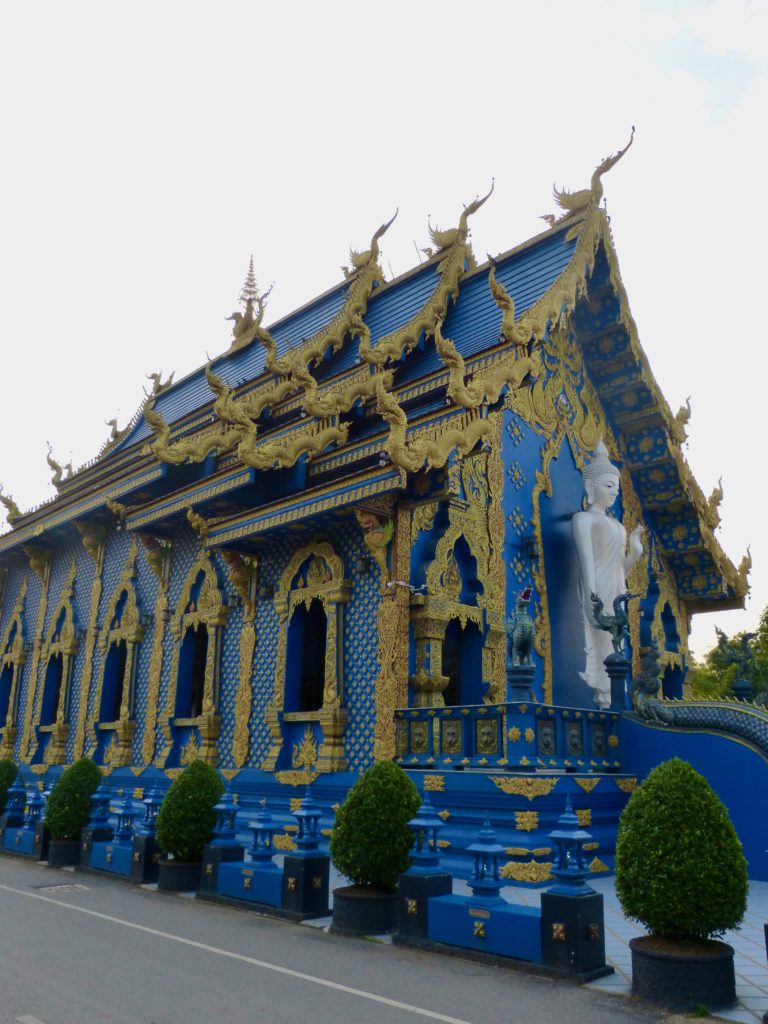



We decided to go to the night market for supper and, on our way back, we caught this light and sound show at the clock tower (It occurs at 19h, 20h and 21h).



After a good night rest we were ready to head on to Chang Mai, but stoped first at Mae Sai, the northernmost city of Thailand. It is mainly a stepping stone for visits to Myanmar. There was not a lot to see or do besides watch people crossing the bridge/border.
After that, we continued to what is called the Golden Triangle where the three borders of Laos, Myanmar and Thailand meet. Again, not much to see.
Next came another colorful temple: the Wat phra that doi wao, also known as the Scorpion Temple, it is located on a mountain and offers views over to Myanmar. They were preparing the funeral of a famous monk so there was a lot of activity decorating the temple and its surroundings.
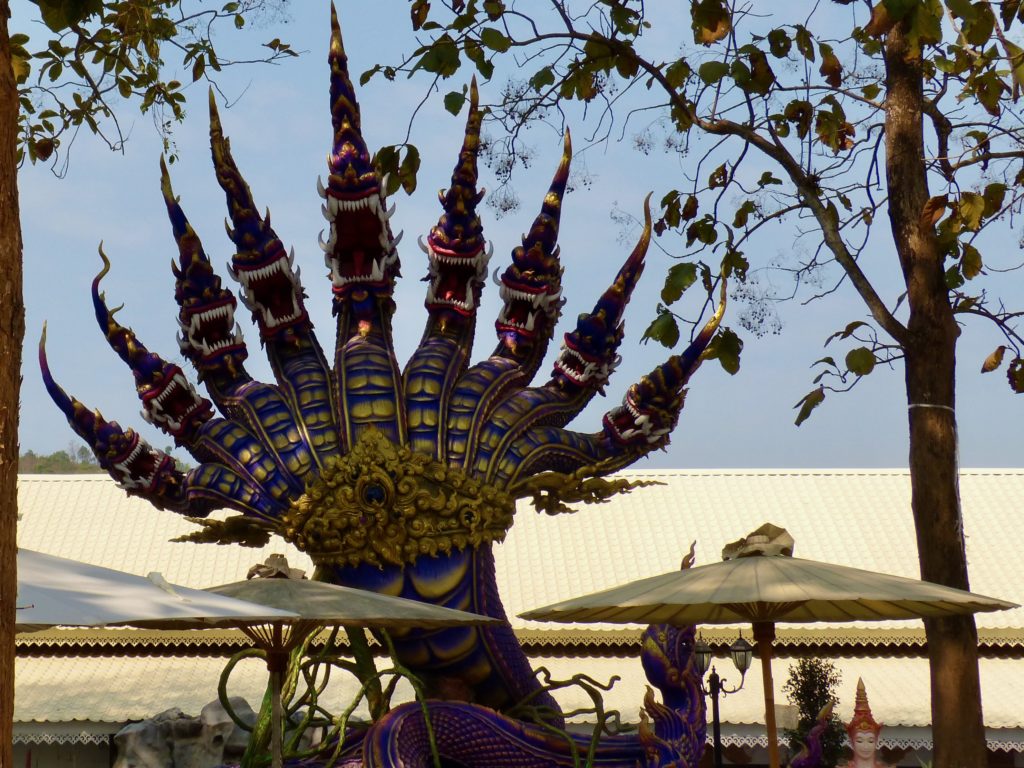

Our next stop was the White temple (Ban Rong Khun, Tambon Pa O Don Chai). This is quite a unique sight! It is a “modern” temple, designed by Chalermchai Kostipipat, (opened in 1997), all white and sparkly with a lot of details. The dazzling effect is achieved through a blend of whitewash and transparent mirrored chips. The main building is reached by crossing a bridge over a small lake. In front of the bridge are hundreds of outreaching hands that symbolize unrestrained desire. The bridge proclaims that the way to happiness is by foregoing temptation, greed, and desire. Next to the lake stand two very elegant Kinnaree, half-human, half-bird creatures from Buddhist mythology. After crossing the bridge, the visitor arrives at the “gate of heaven”, guarded by two creatures representing Death and Rahu. Everything is white everywhere save for one gold building. The gold symbolizes how people focus on worldly desires and money, while the white building represents the idea to make merit and to focus on the mind, instead of material things and possession.


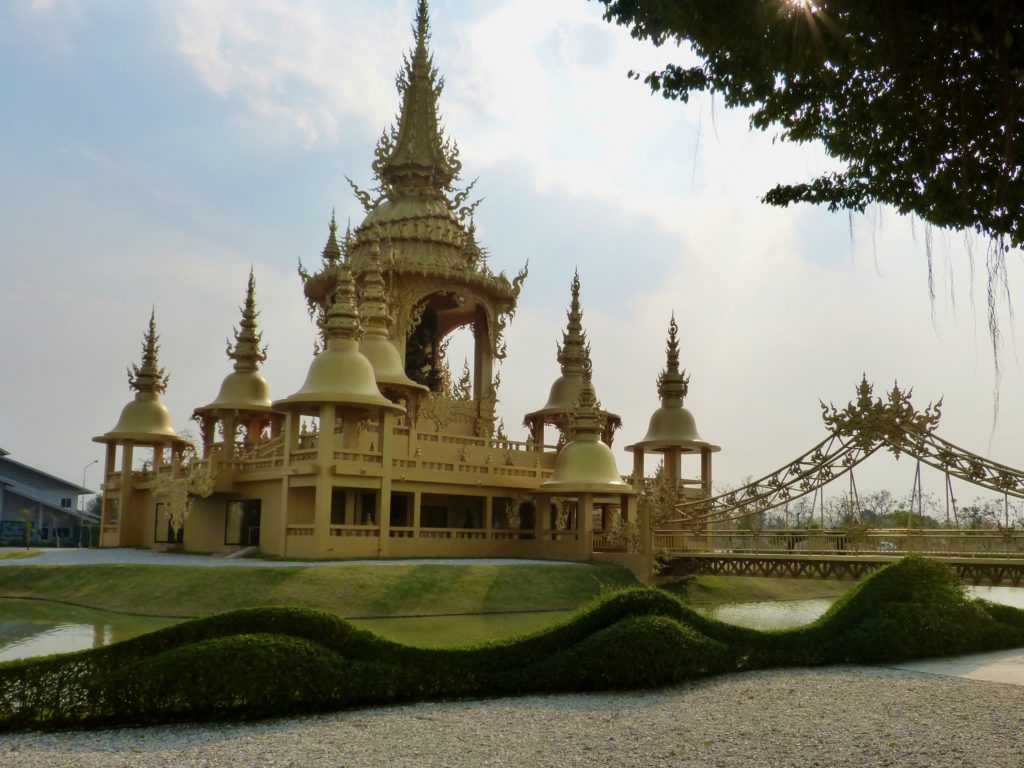

For our twelfth day, of travel, we had booked a cooking class (in Chiang Mai). The set up was very efficient. We first visited a “traditional” house, with a presentation of their family and way of life. Next came a walk through their garden/forest, where fruit, vegetable and spices grow wild. Then we were assigned a teacher and a hut. Everything was cooked over open fires. The results were as tasty as they were appetizing. Amazing how many different dishes we managed to prepare in a rather short time! As always in these situations the recipes never quite work once you get back home, but we got enough information to be able to replicate most of the dishes. We also stopped by the market later to pick up some of the more local ingredients. (It was stressful at customs/security check points on our way home but everything made it through).
On the way back to the hotel we stopped at Wat Phra That Doi Suthep. It is situated at an elevation of 1,073 meters so it offers spectacular views of the city. Because we had changed guides by that time, and she was more religious than the previous one, we were encouraged to go kneel to get a blessing and a good spray of holy water from the monk, plus get our “fortune” as well as a rope bracelet… it was interesting.

Hard to visit Thailand (or more specifically the Chang Mai region) without doing some kind of activity with the elephants. If you are familiar with my story you know of my affection for those adorable pachyderms. We were adamant that we did not want to visit any organization that abuses the animals in any way so, on day 13, we chose a park that claims to be an ethical and sustainable eco-tourism Elephant Sanctuary: Baan Chang Elephant Park. Most of their elephants came to them injured, maimed or just abandoned by whoever owned them (in captivity). Different from the Sheldrick in Kenya where they rescue baby elephants but a rescue mission nonetheless. Having said that I must point out the differences between African and Asian elephants. First of all their weight and size: African elephants are bigger, weighing in around 9 tons while and Asian elephant weigh around 6 tons, then there is the shape of their ears, Asian elephants’ ears are smaller compared to the large fan-shaped ears of the African species. Also only some male Asian elephants have tusks, while both male and female African elephants grow tusks. There are plenty of other minute features, such as skin texture, number of toenails, and trunk characteristics that can differentiate the two types of elephants.
Day 14 Chiang Mai
As we had four days in Chiang Mai, we spent day 14 exploring on our own. Right across the street from our hotel was a large park, and it happens to host a very big flower festival every year. We were there at the end of it, but there was still plenty to impress us, especially the orchids!
Next we decided to go for another massage. This one felt a bit more touristy (prettier set up and gentler treatment) and was a very pleasant experience.
We also tried a nice restaurant.
We explored on foot, visiting the Lanna folklife museum, passing by this monument depicting the three founders of Chiang Mai, King Mengrai, King Ramkhamhaeng and King Ngam Muan.

The city of Chiang Mai currently has more than 350 temples and among them, Wat Phra Singh is undoubtedly one of the largest, one of the most visited and one of the most interesting of all. It is located within the city walls of the ancient city. It is a magnificent temple which houses within it a number of old images of Buddha which are highly revered by the local people.
The construction of the temple dates back to 1345 and it was originally used to house the ashes of a former king.
Our trip ended with a stay at an island resort. We chose Koh-Samui, located in the Gulf of Thailand, over Phuket, located in the Andaman Sea, because we wanted a more quiet environment. Our resort was lovely and restful, but despite the brochure photos, it did not have a beach or ocean access to speak of. They did have several infinity pools, one of which even had integrated water jets which were lovely.
The accommodations were scattered up a mountain. Thankfully there were readily available shuttles. The view from our balcony was beautiful.
And we flew back… leaving behind a fascinating country with an amazing culture steeped in history and yes, some American influences too.


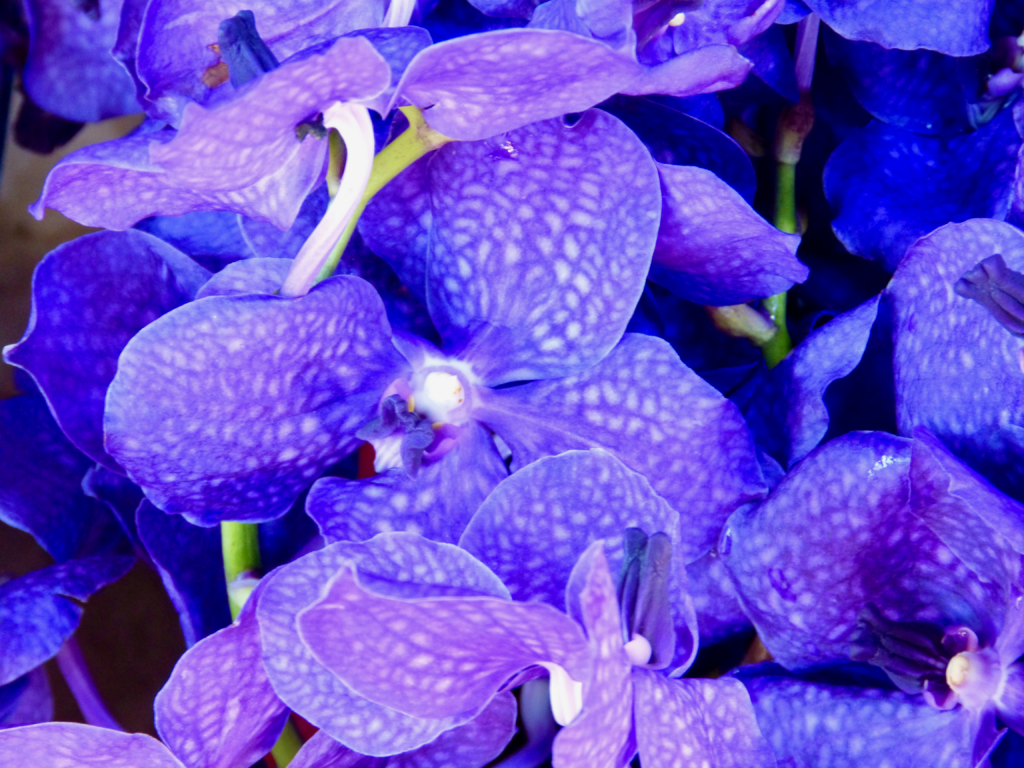

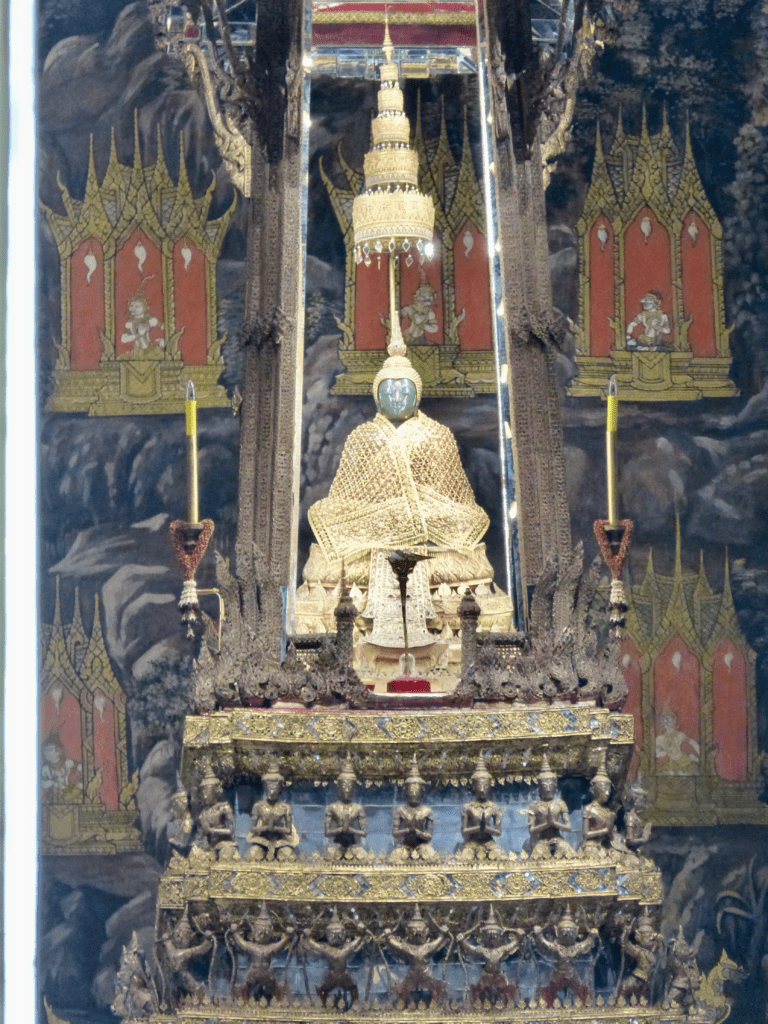

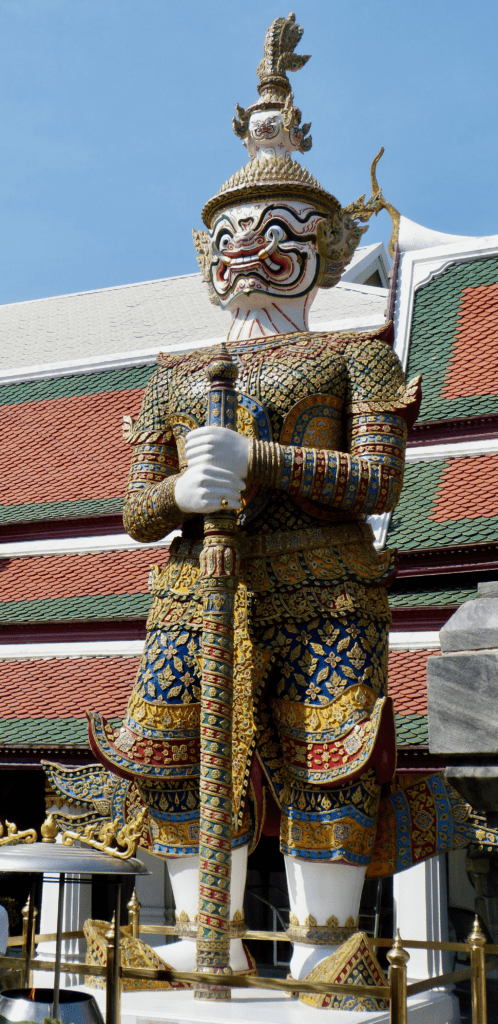

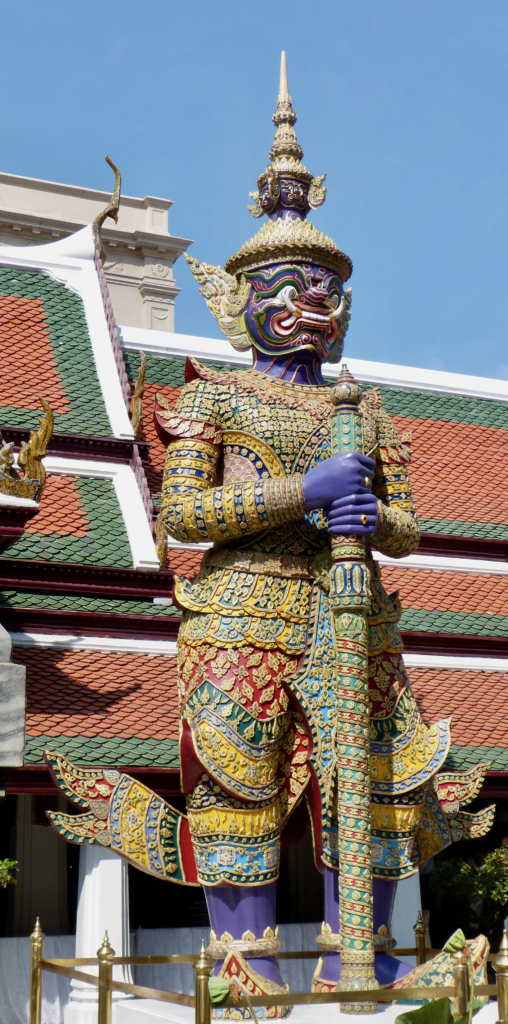

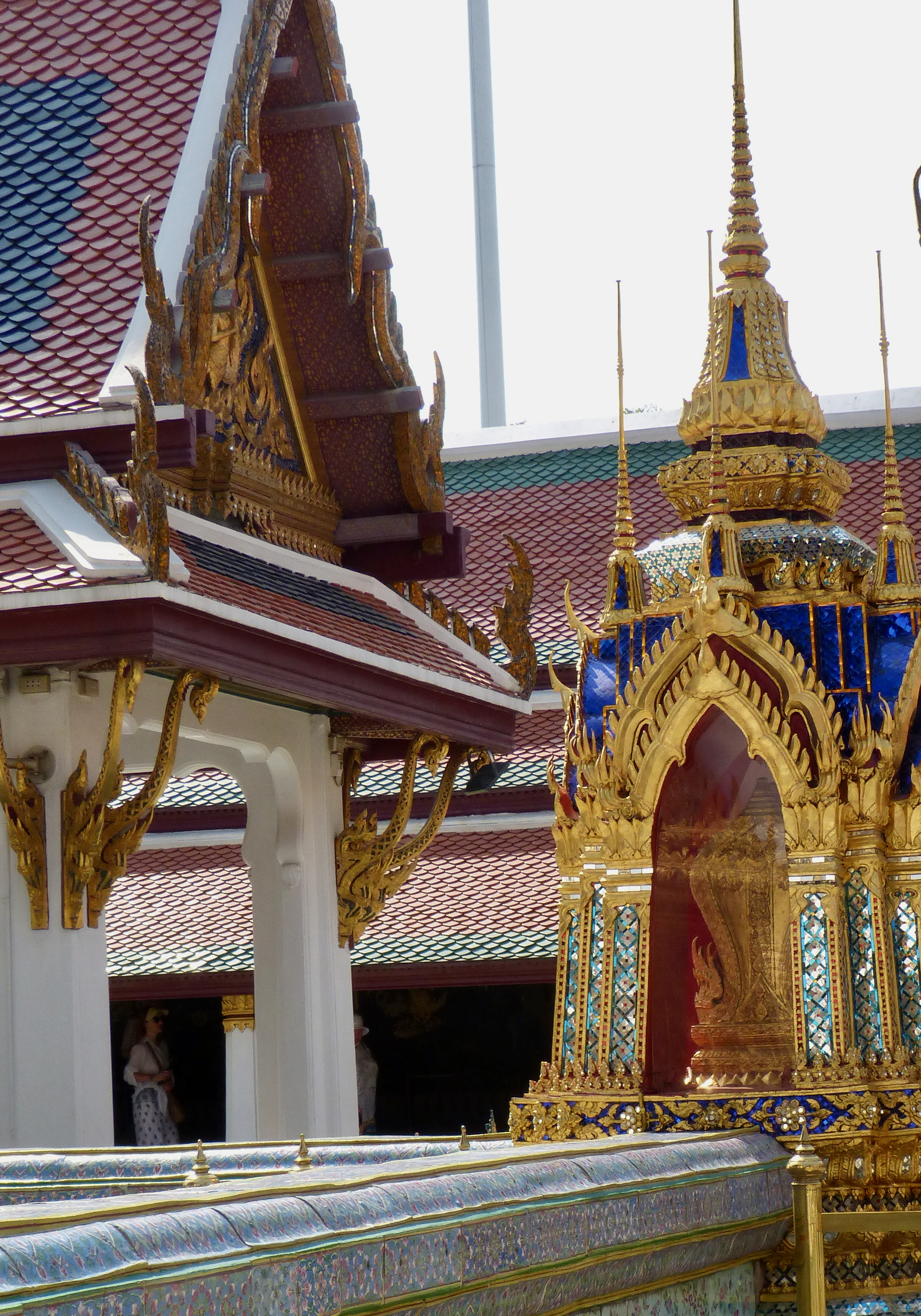


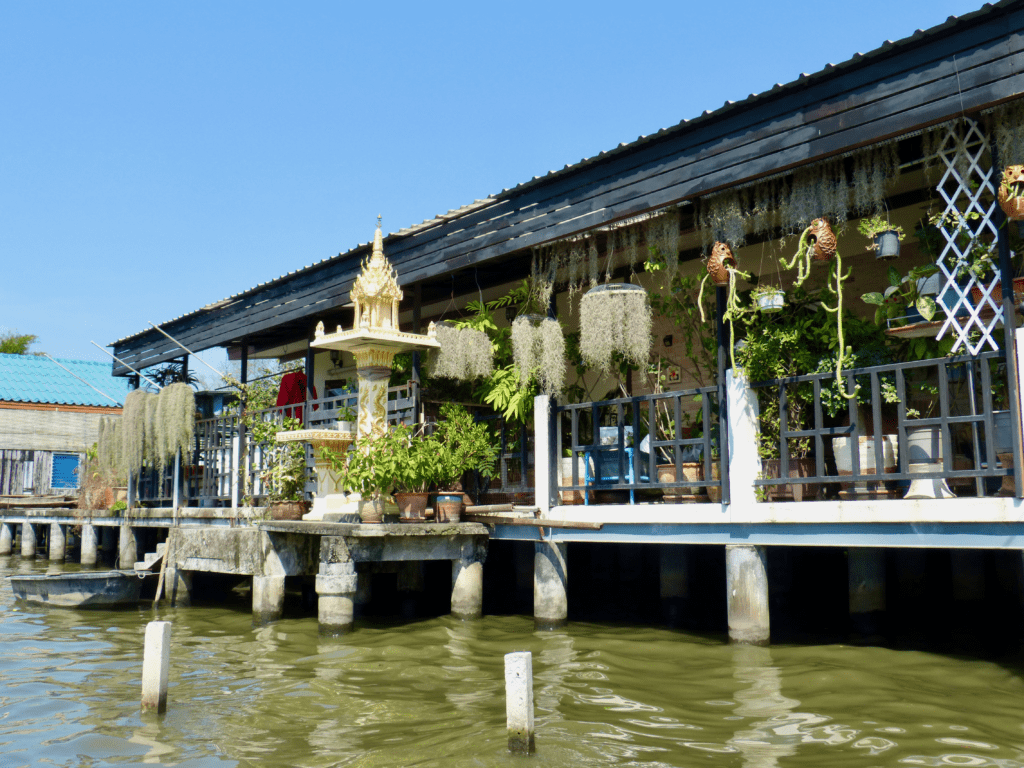
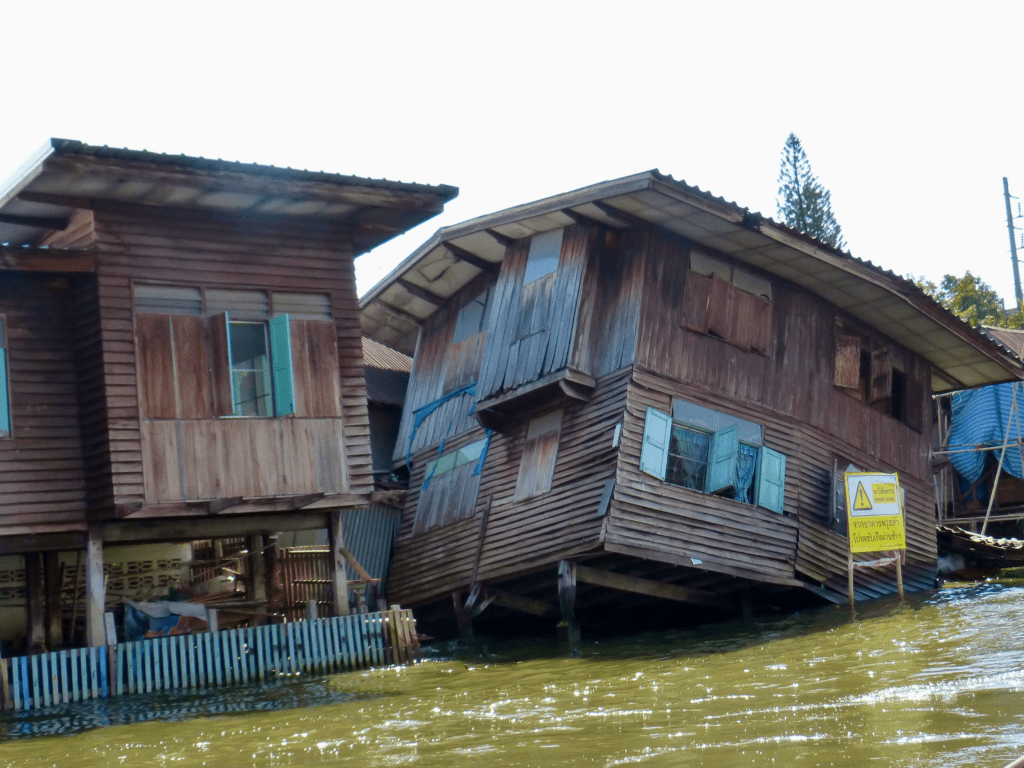
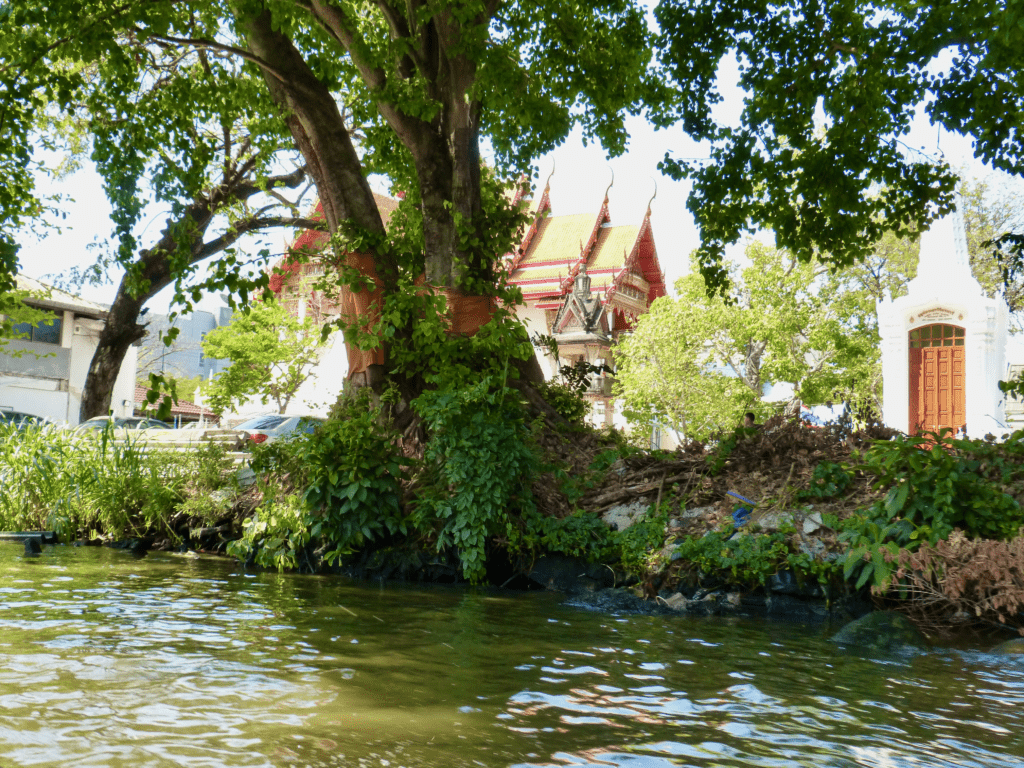
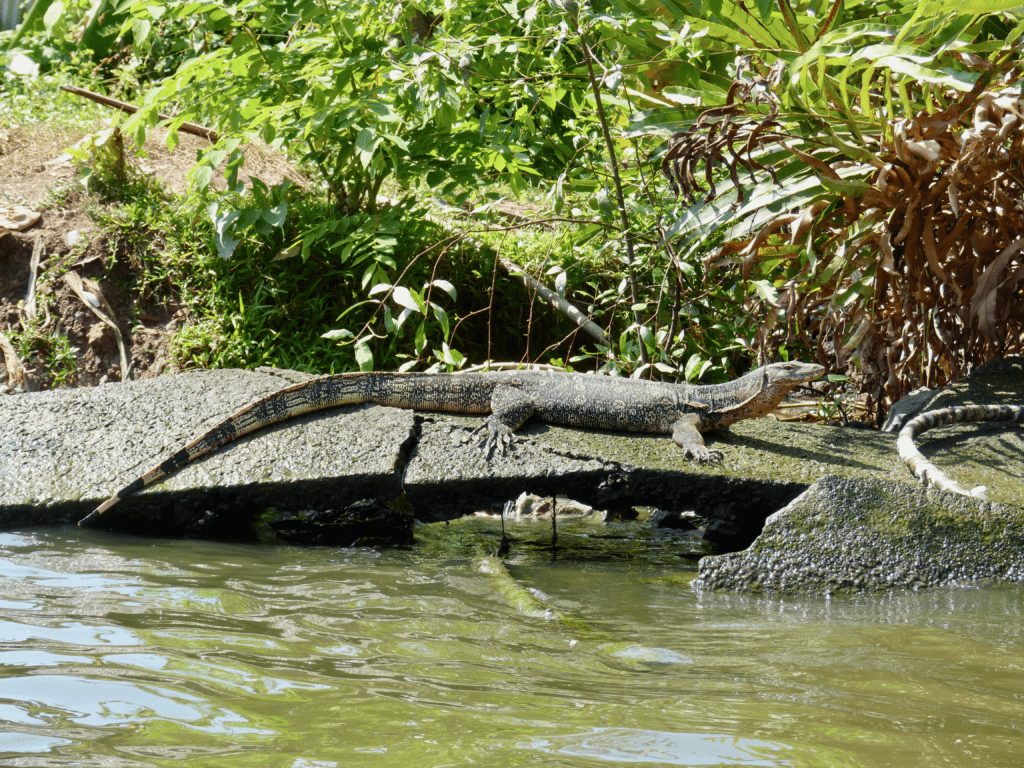




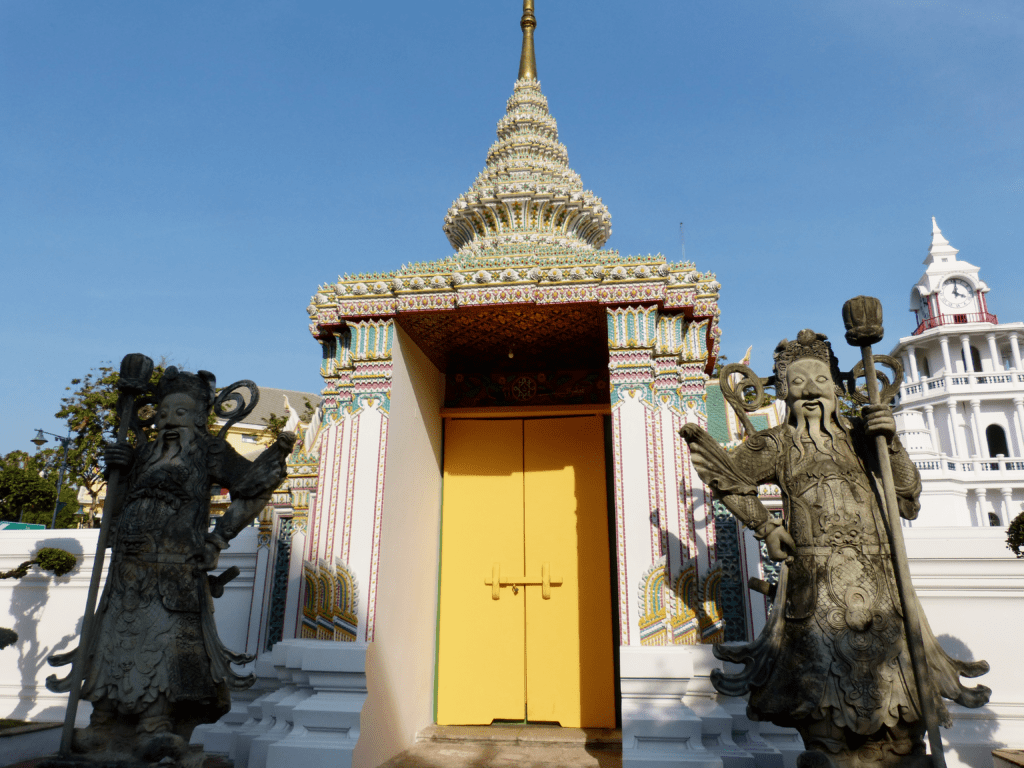
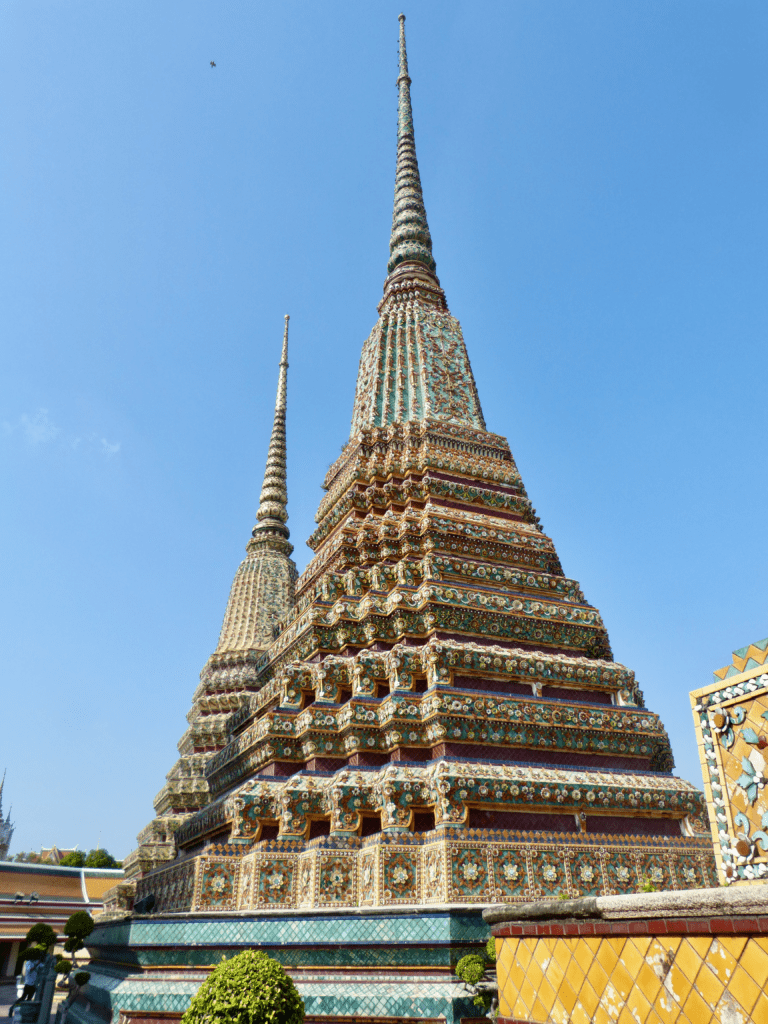
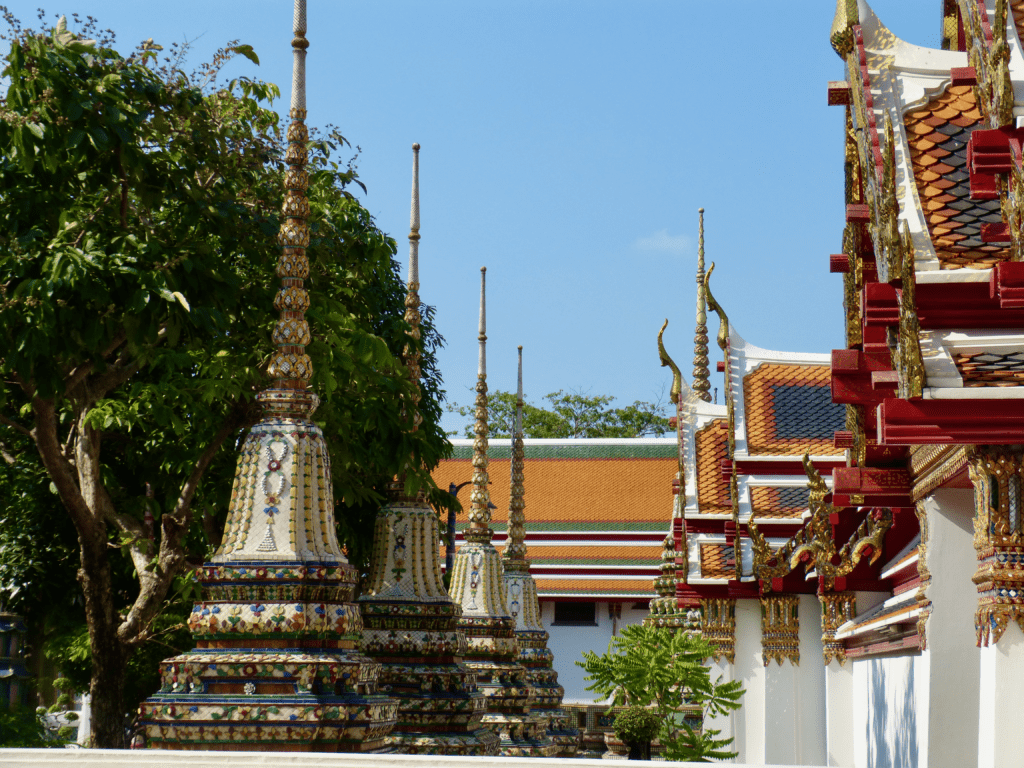





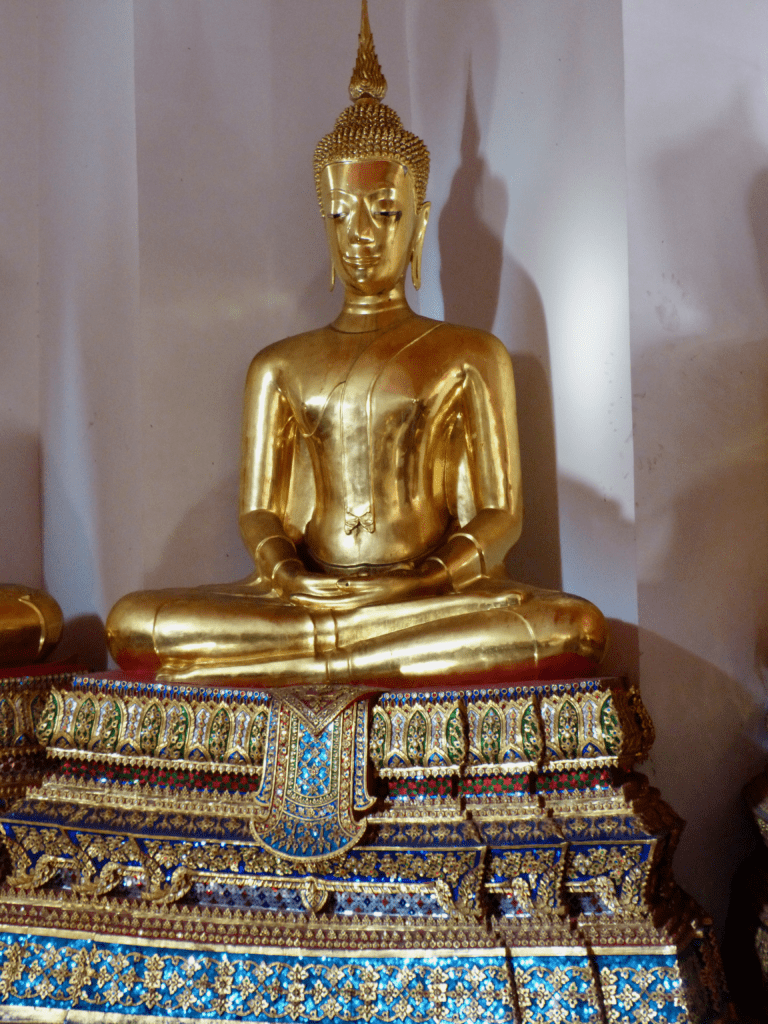



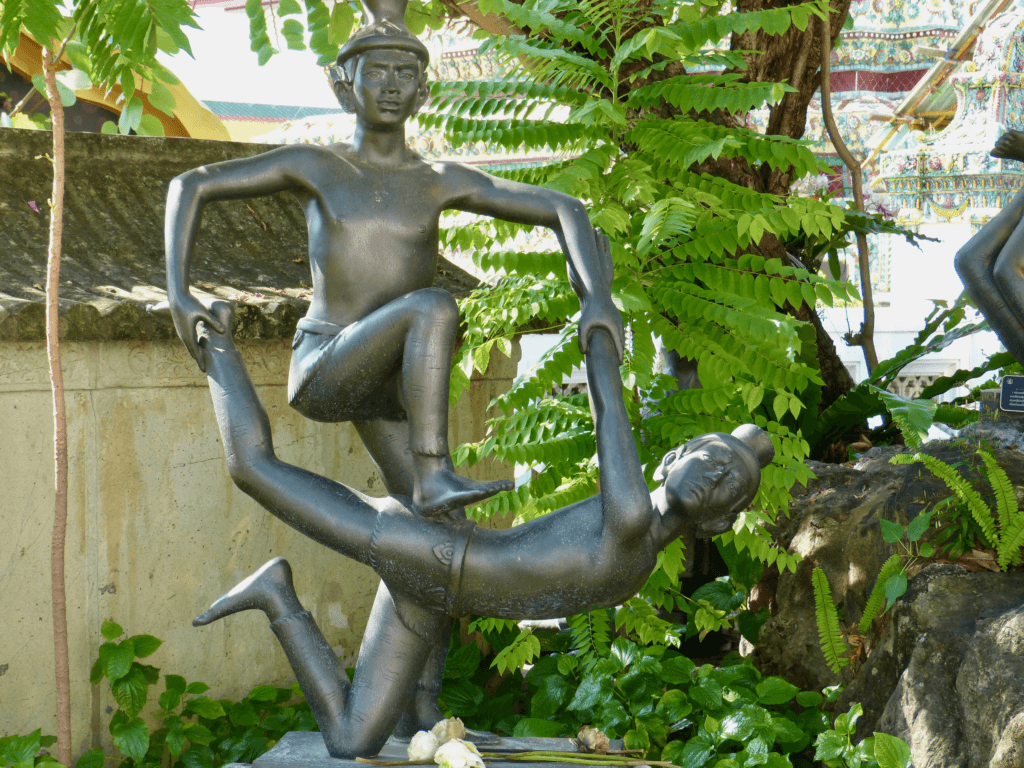






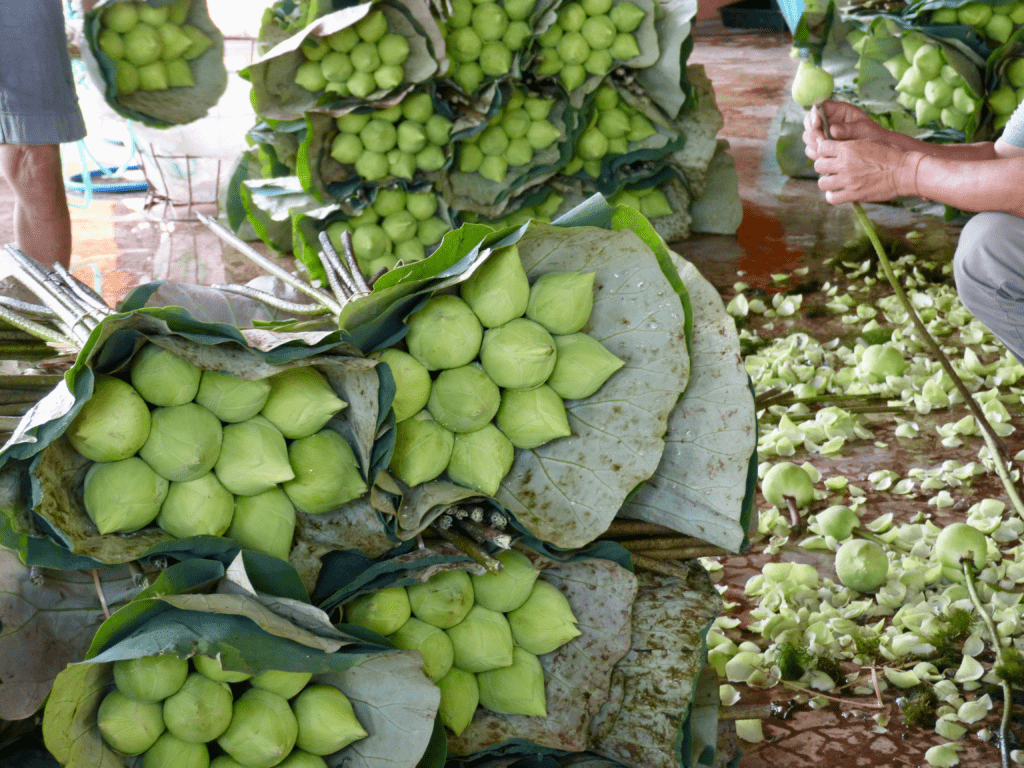


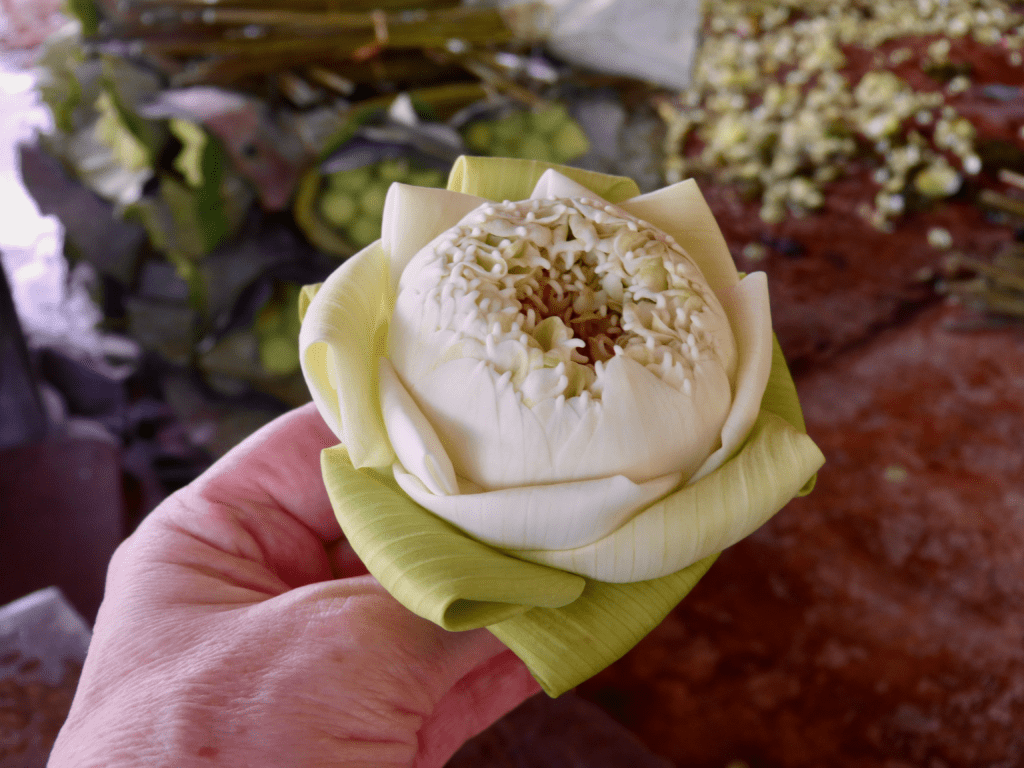
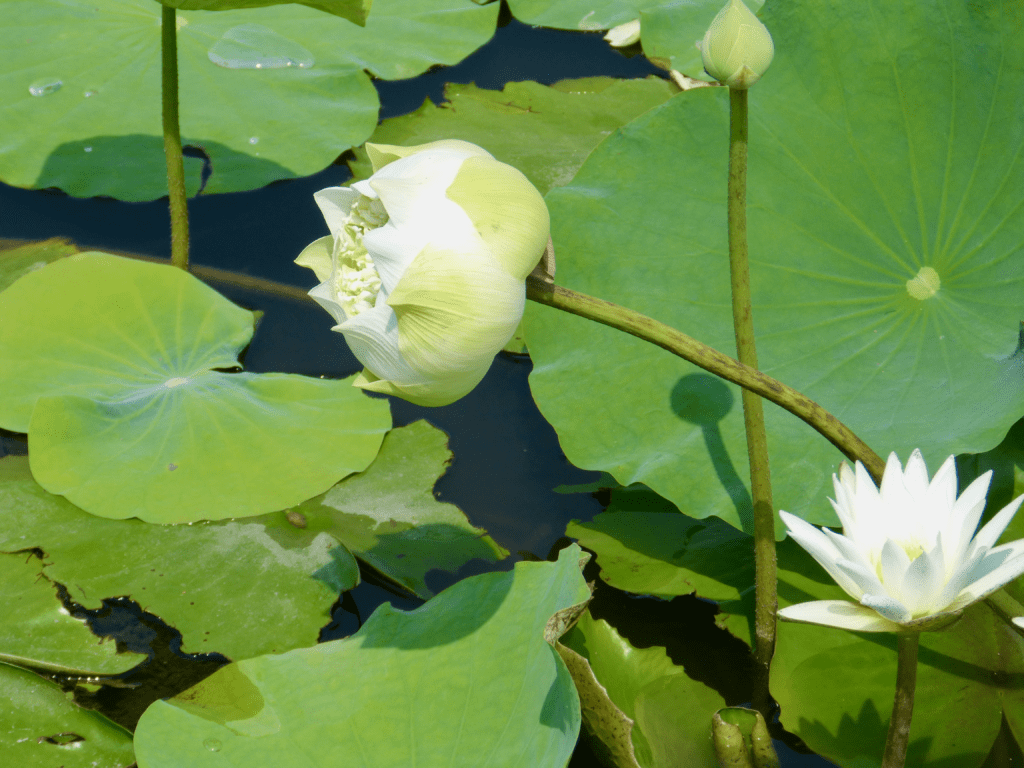


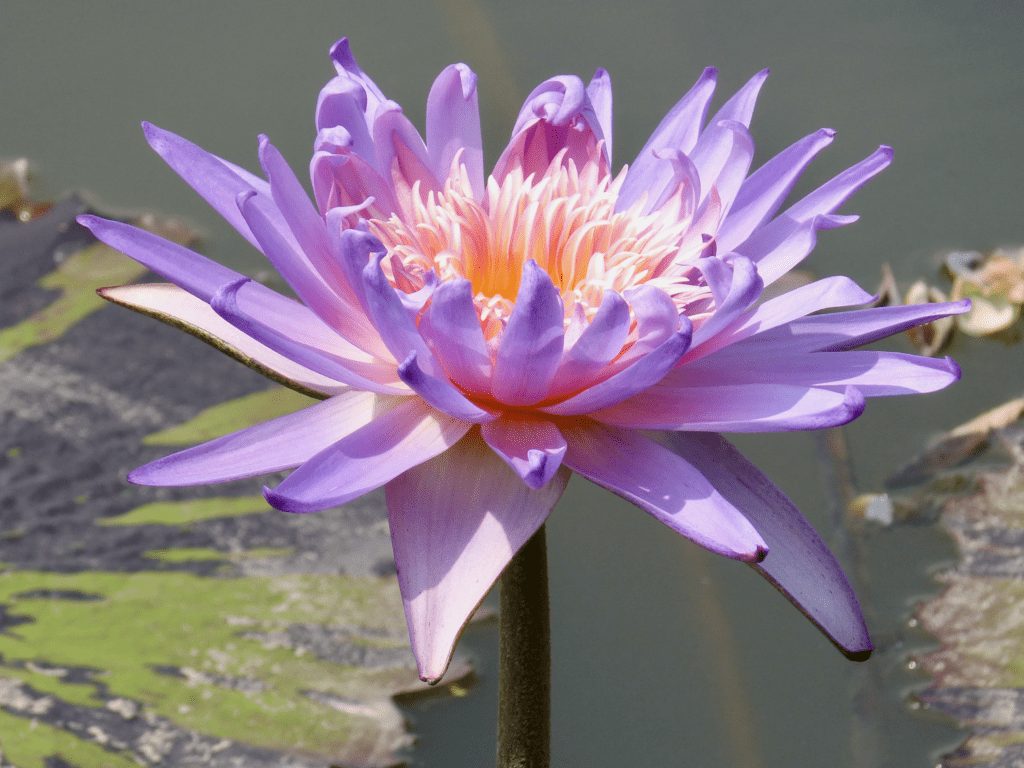


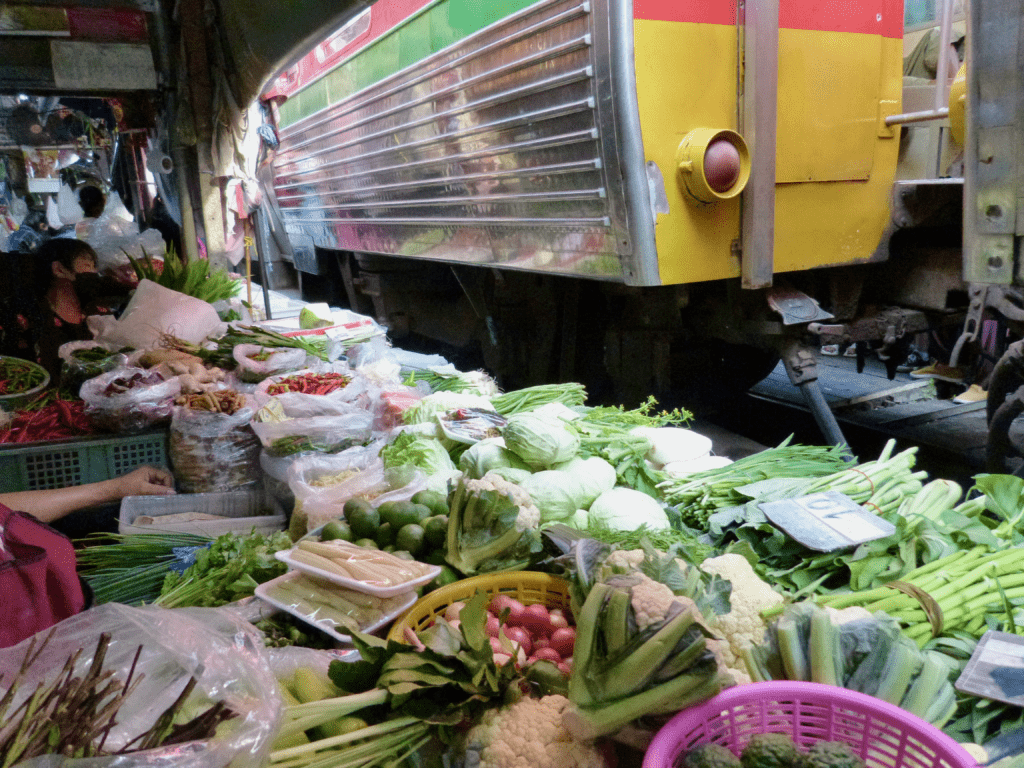
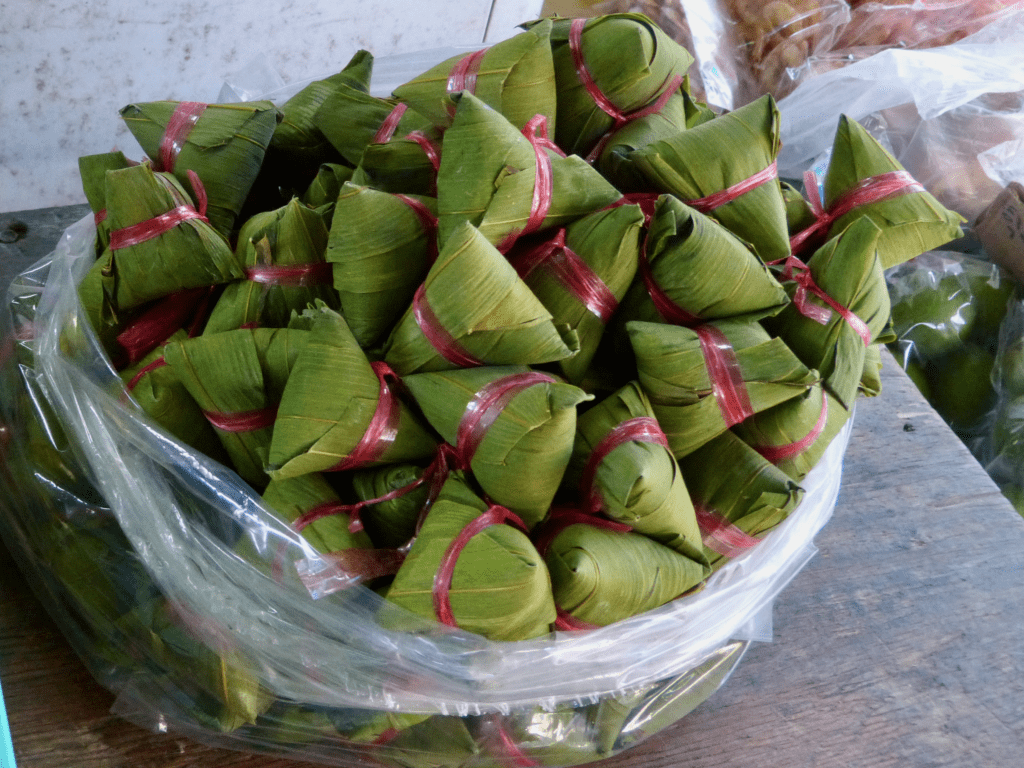

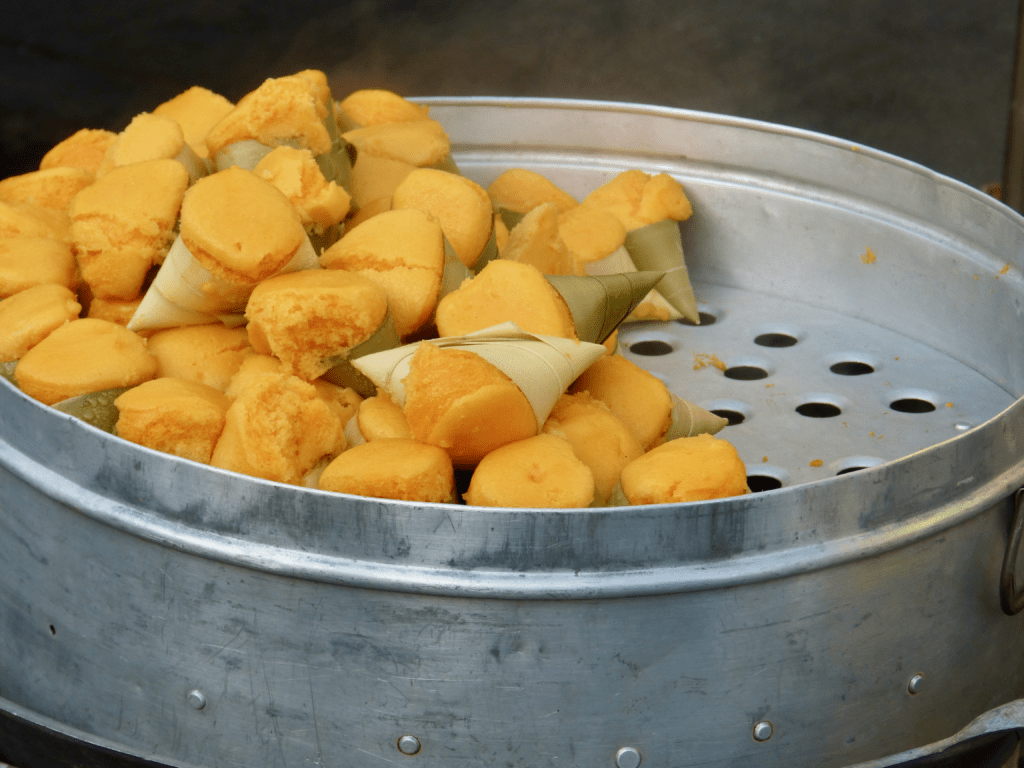


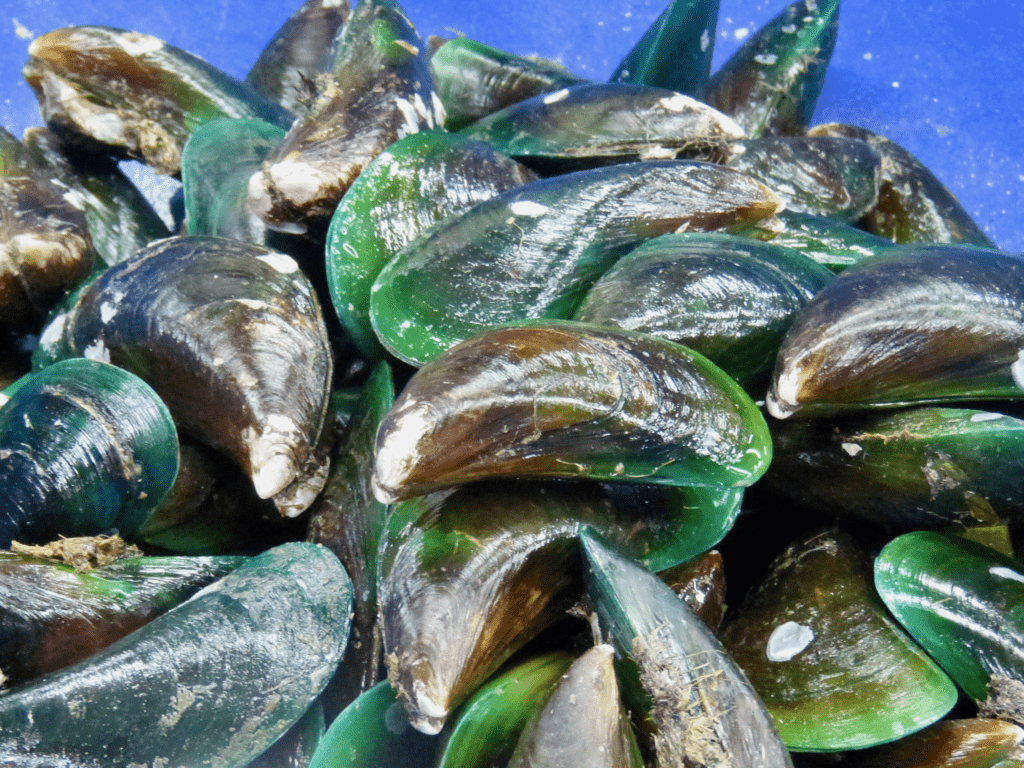
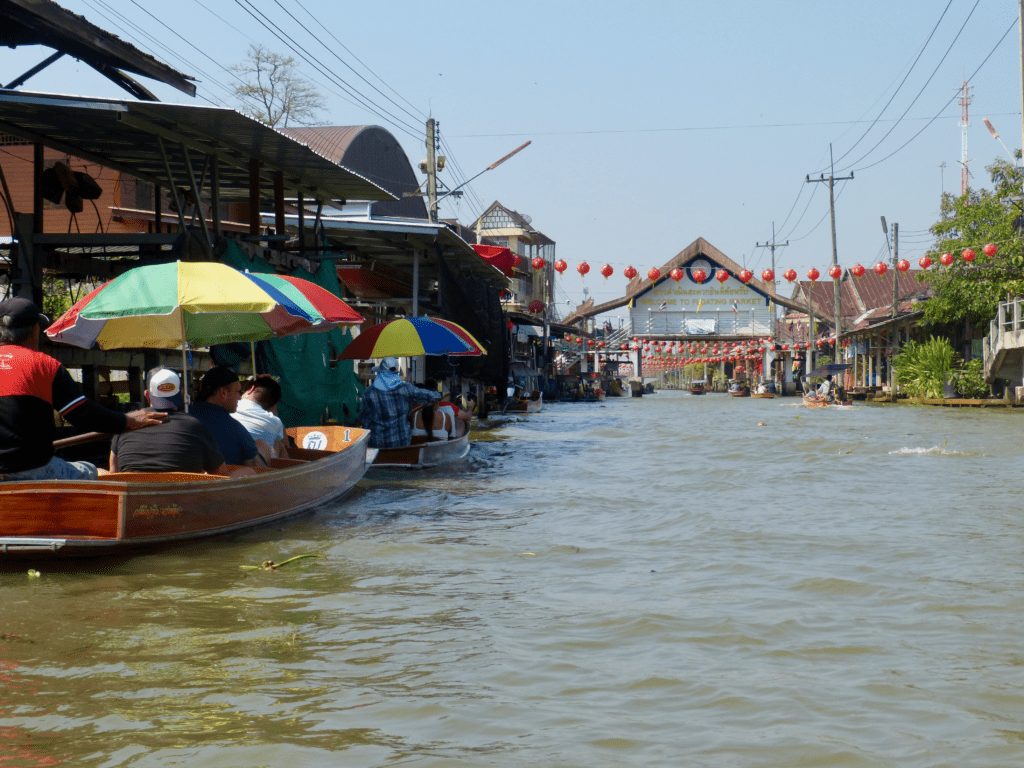

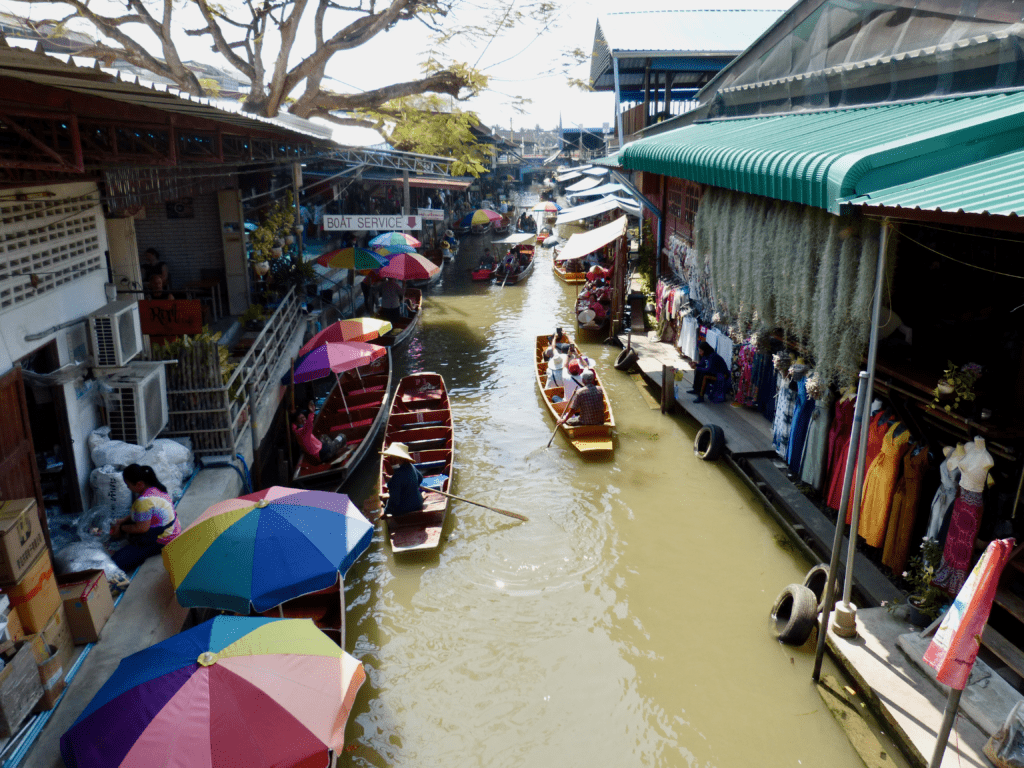



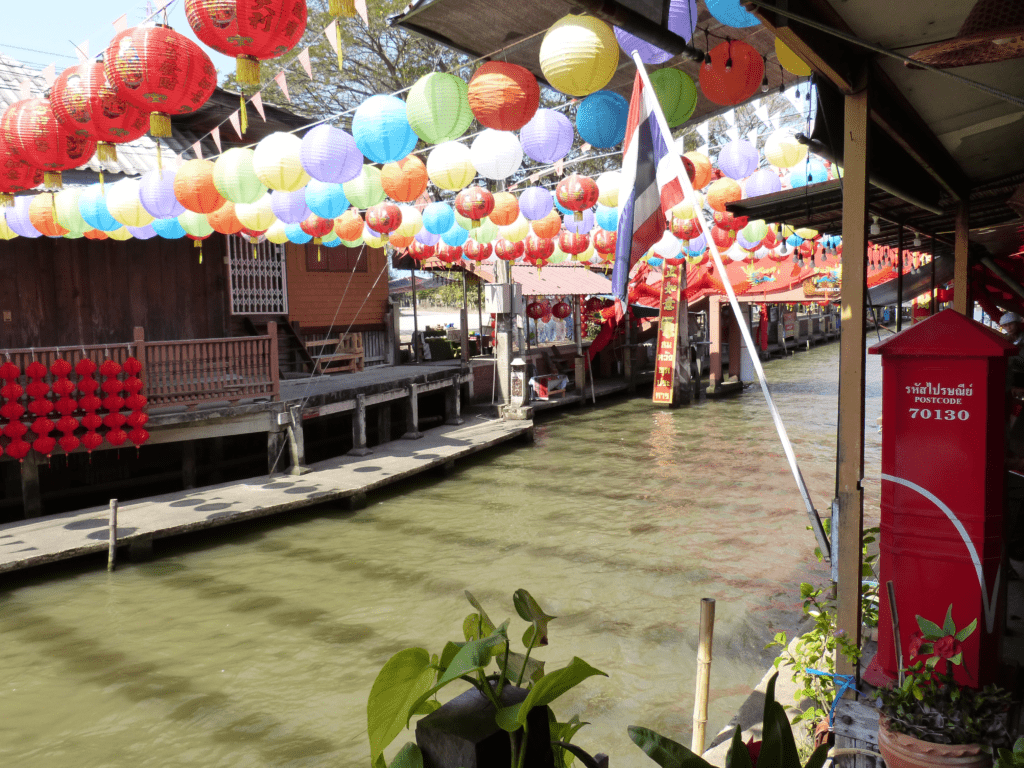



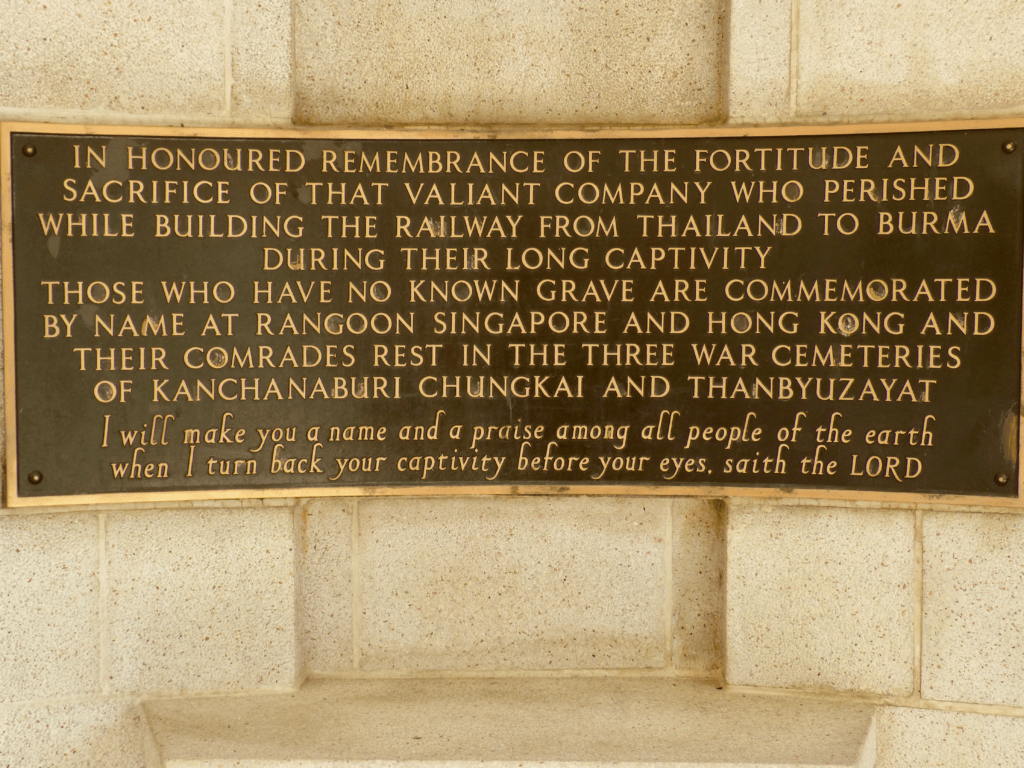
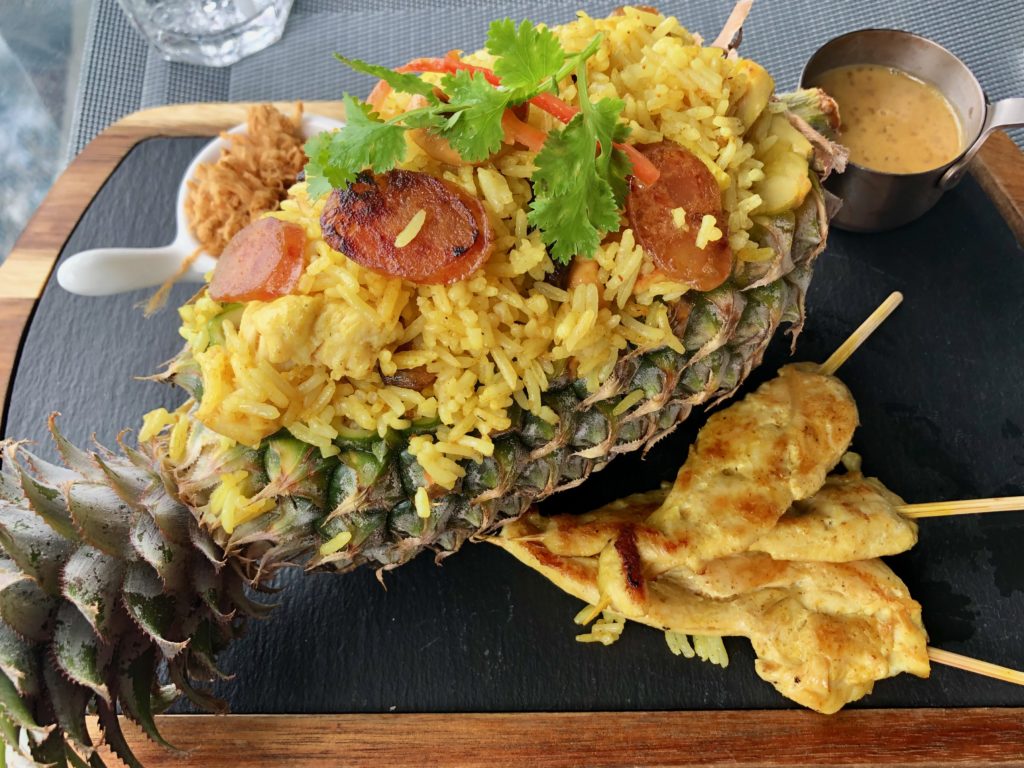
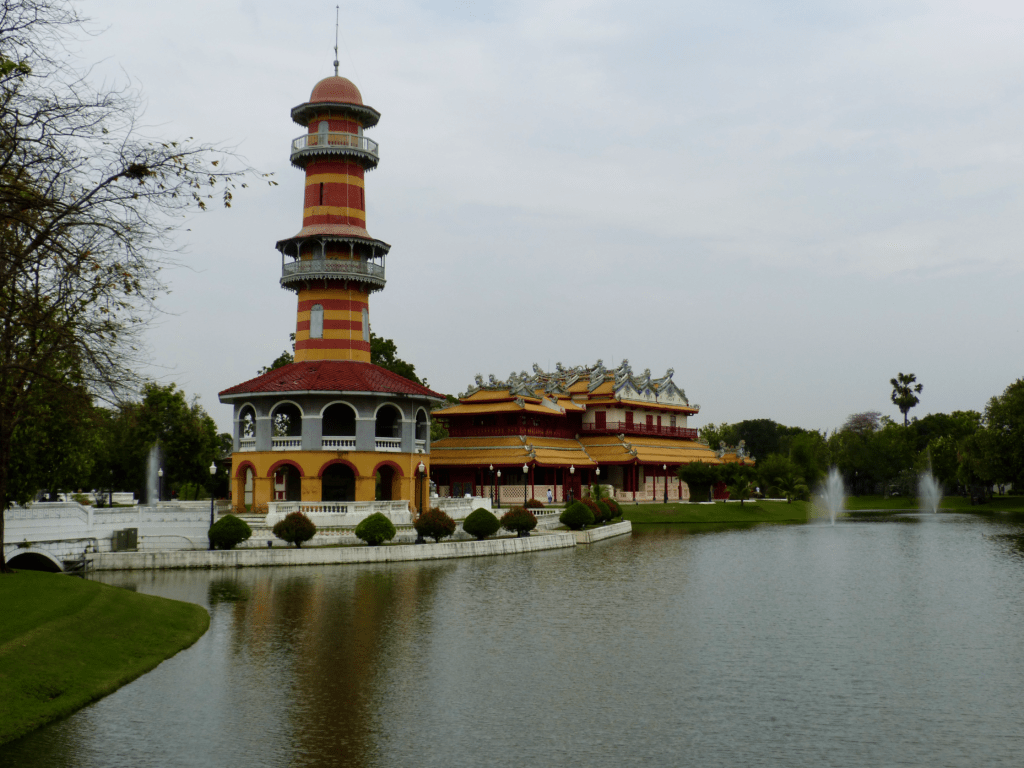
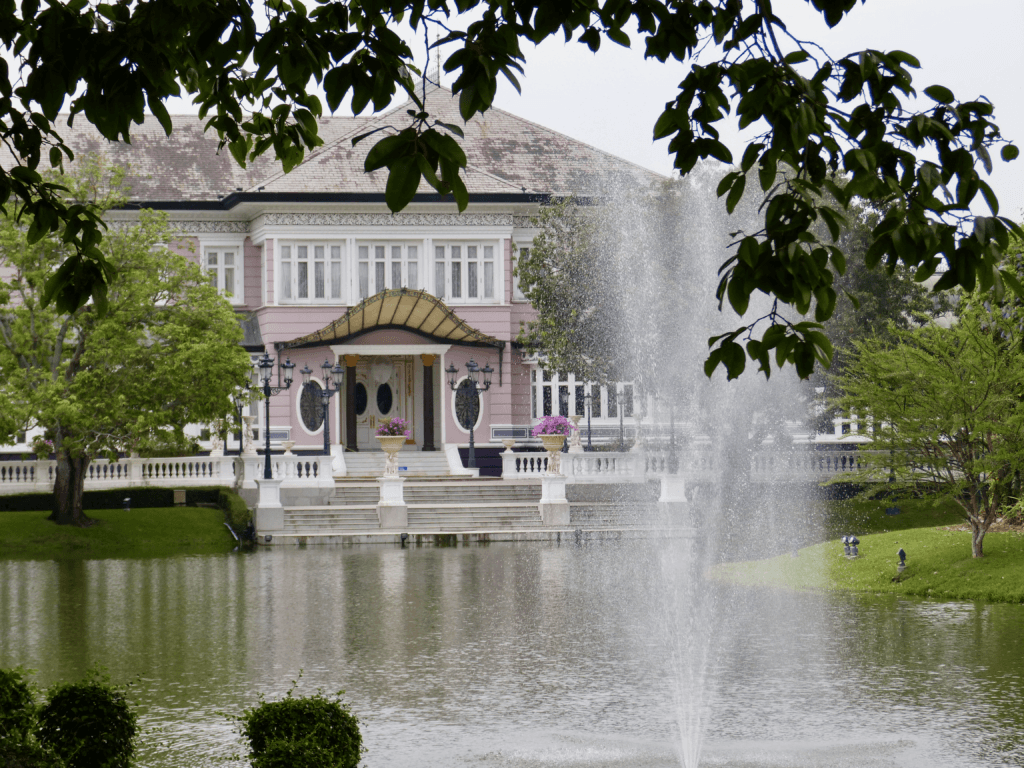
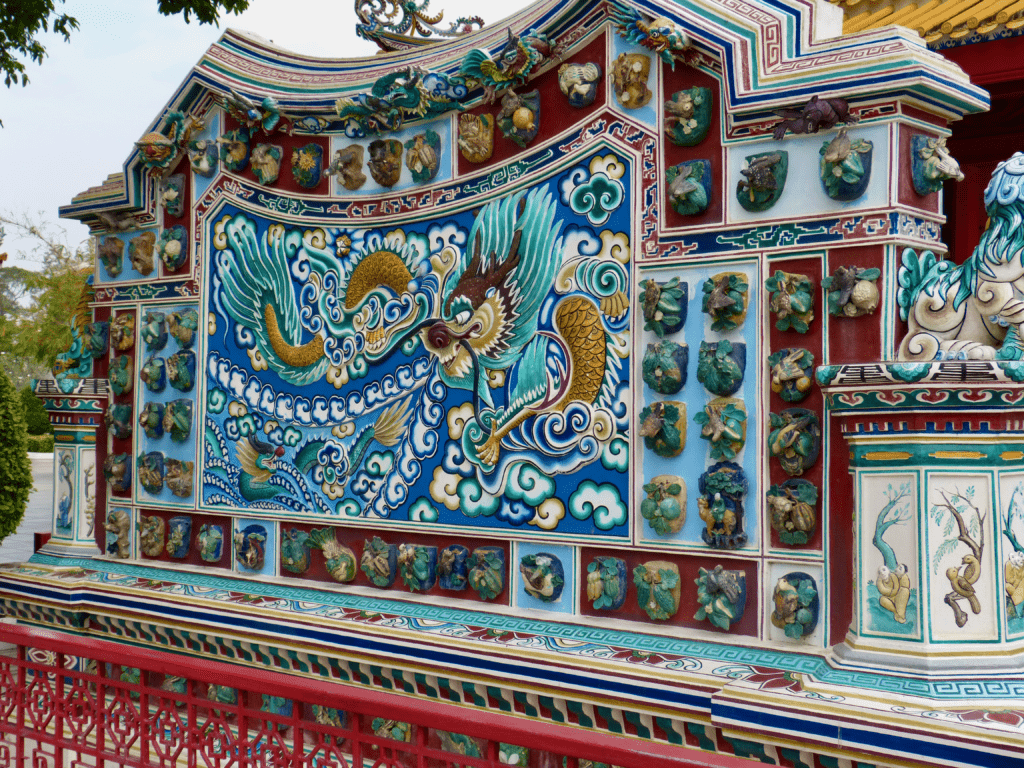



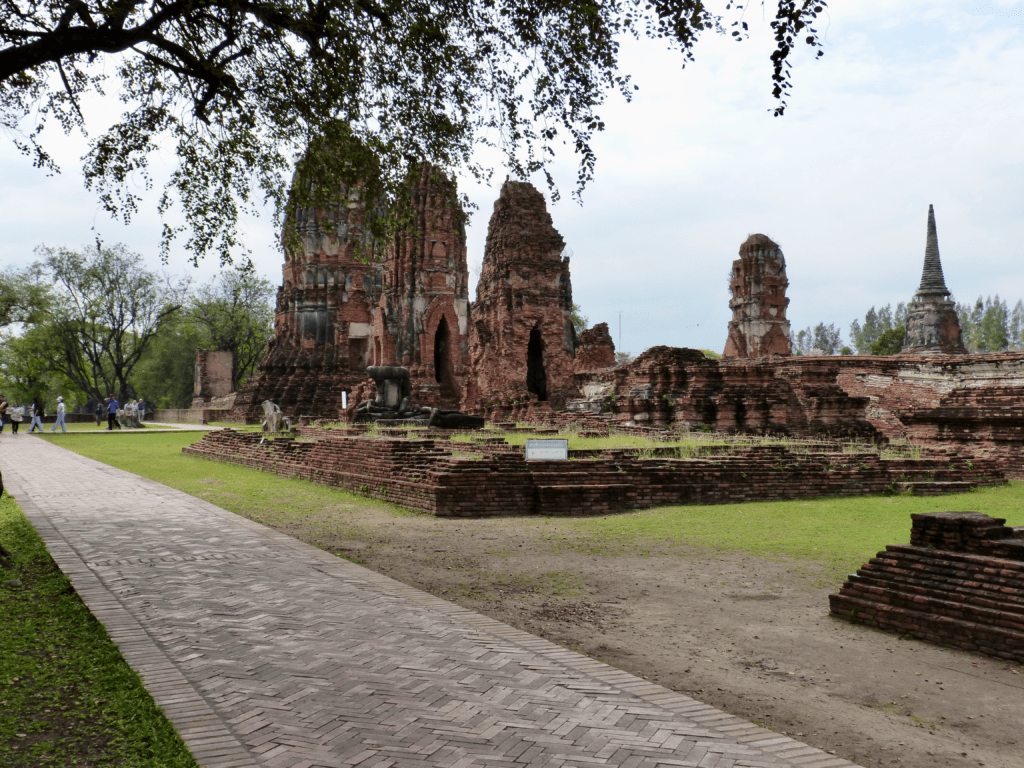



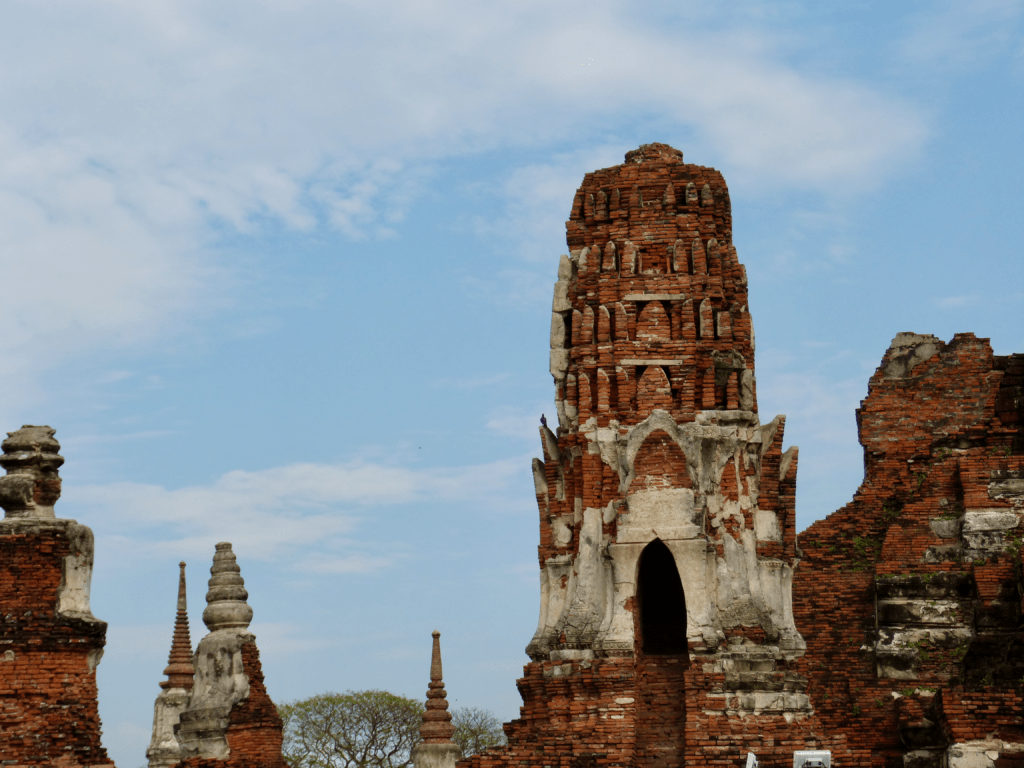
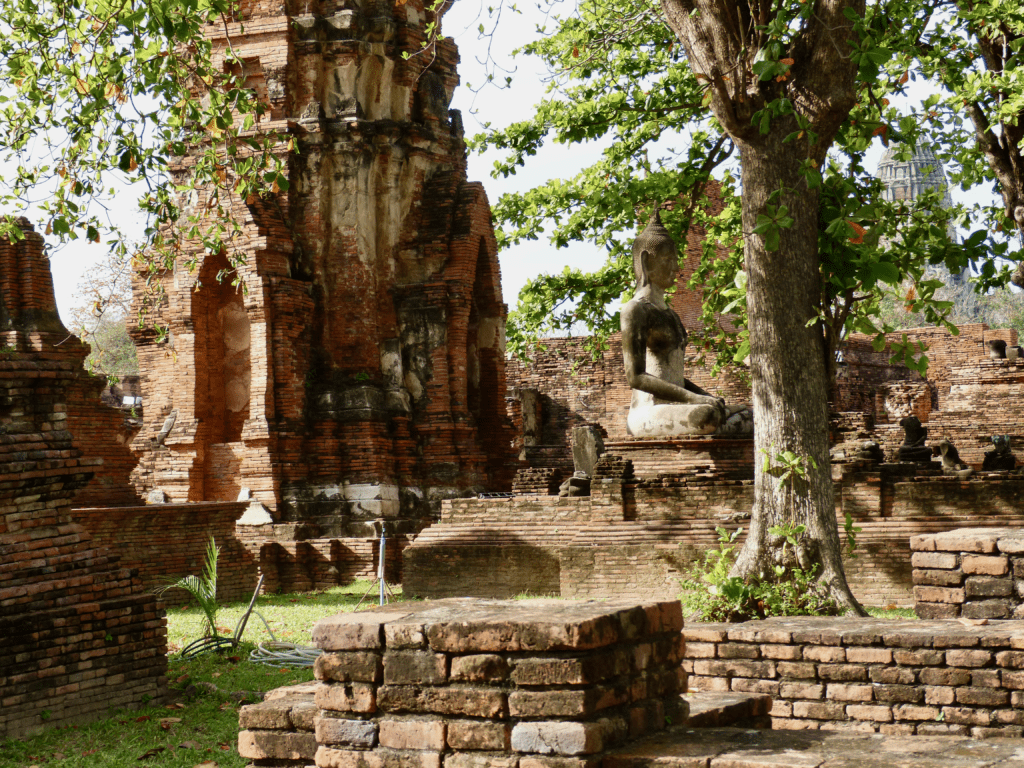



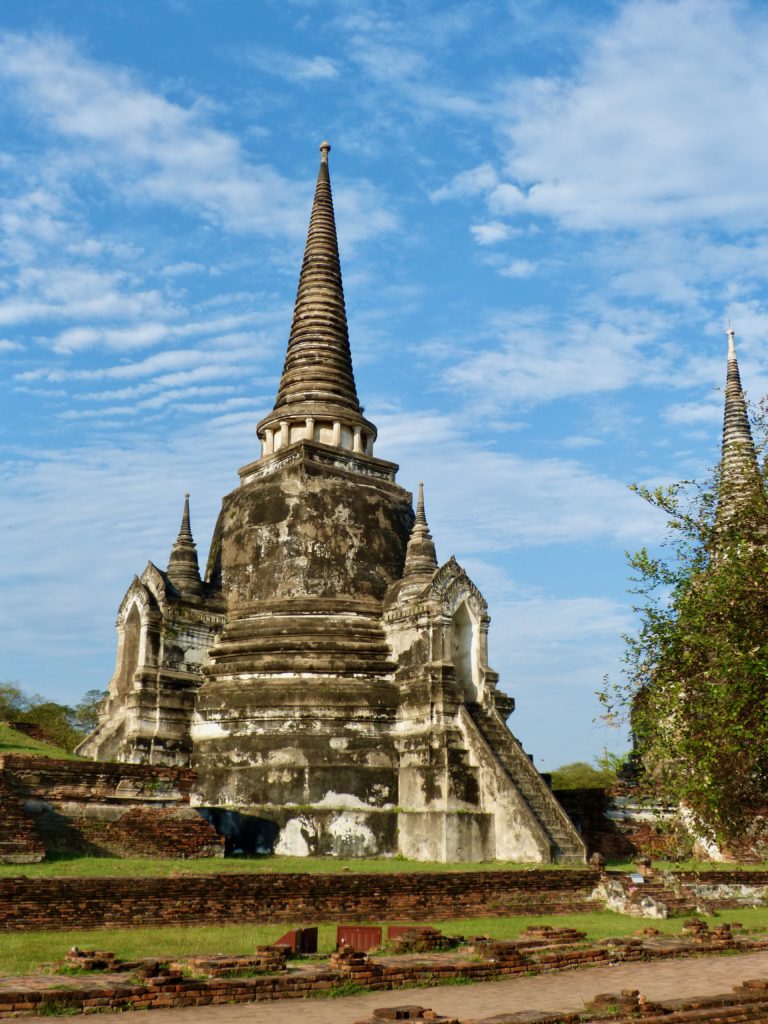
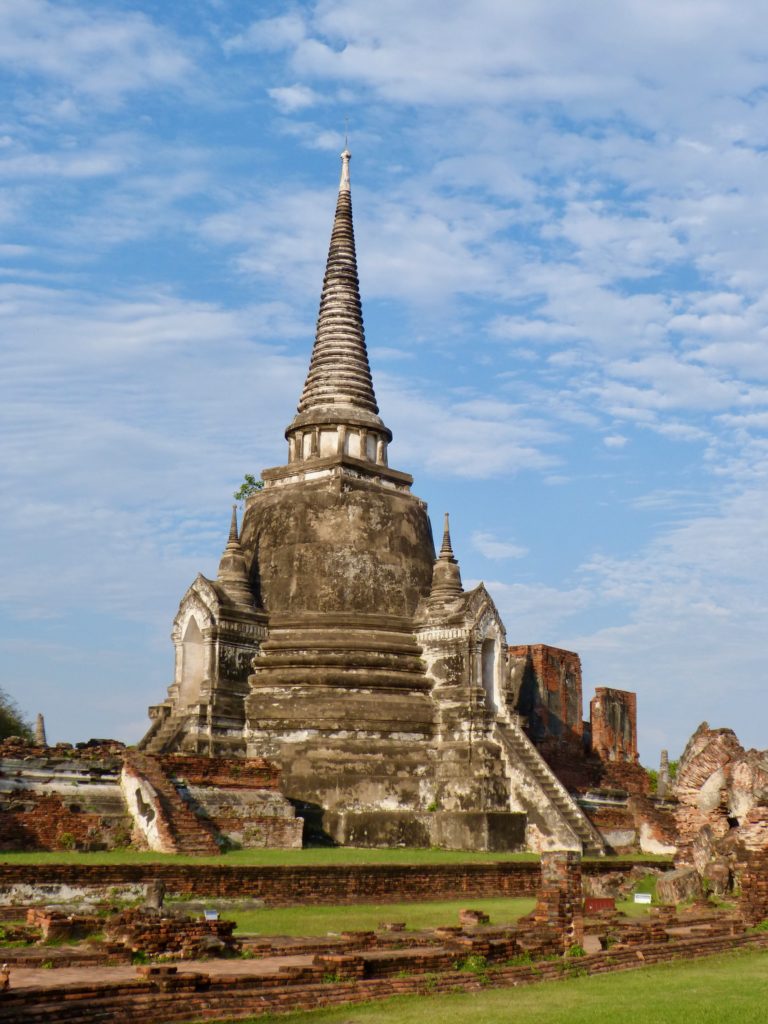















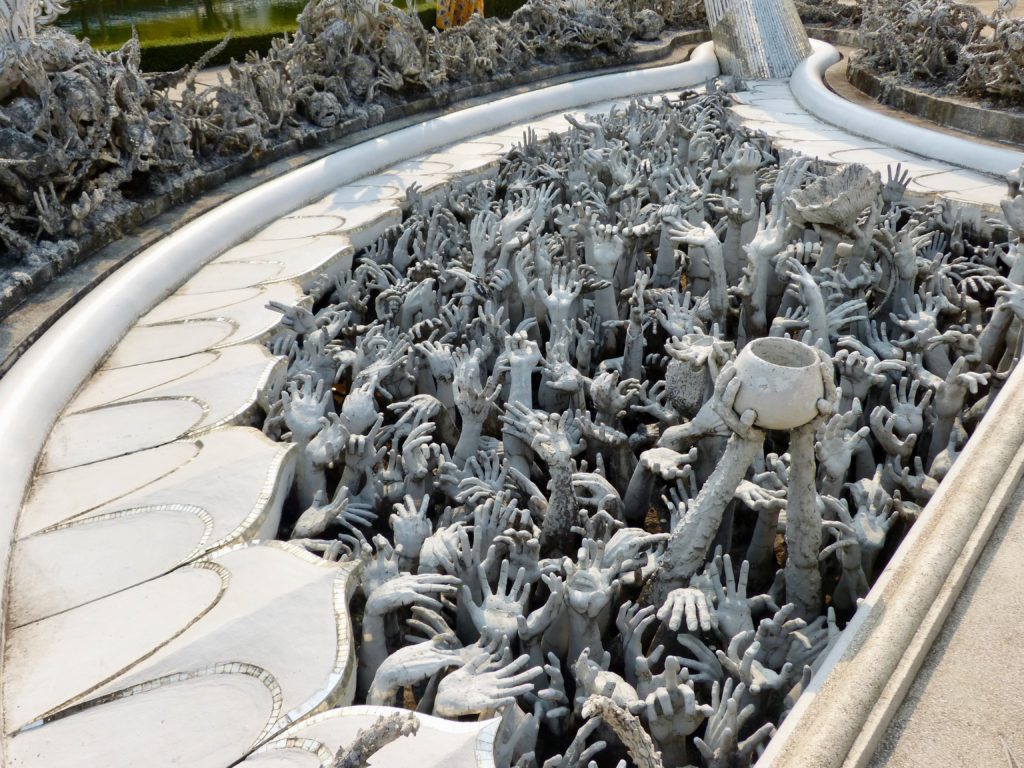





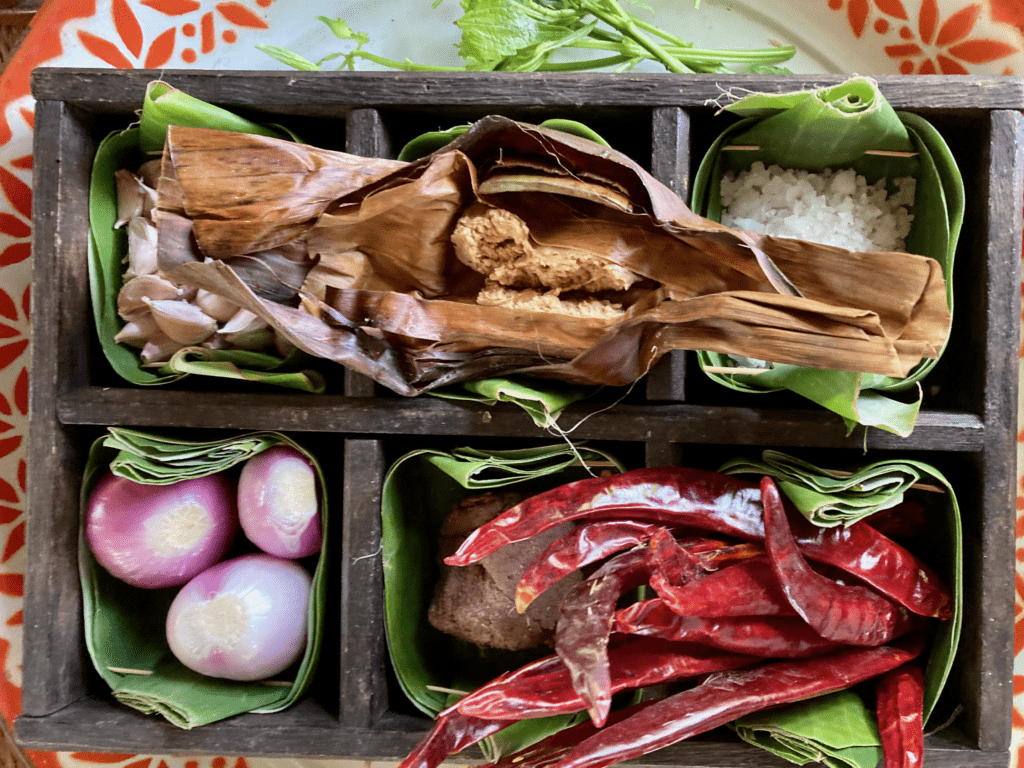
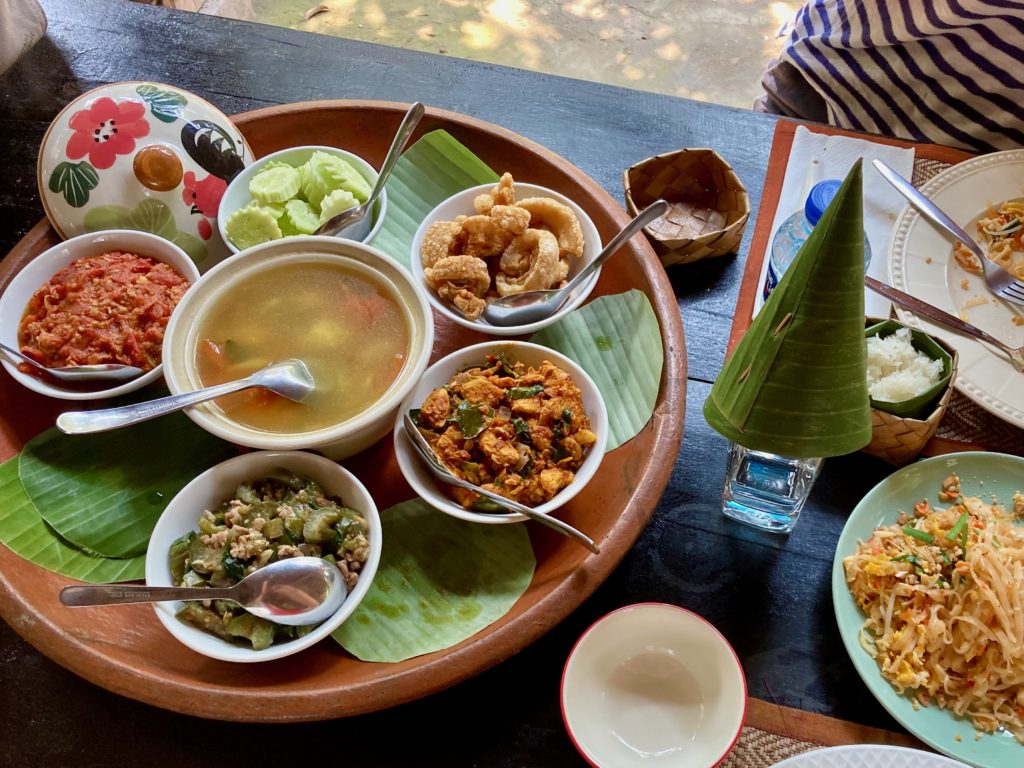





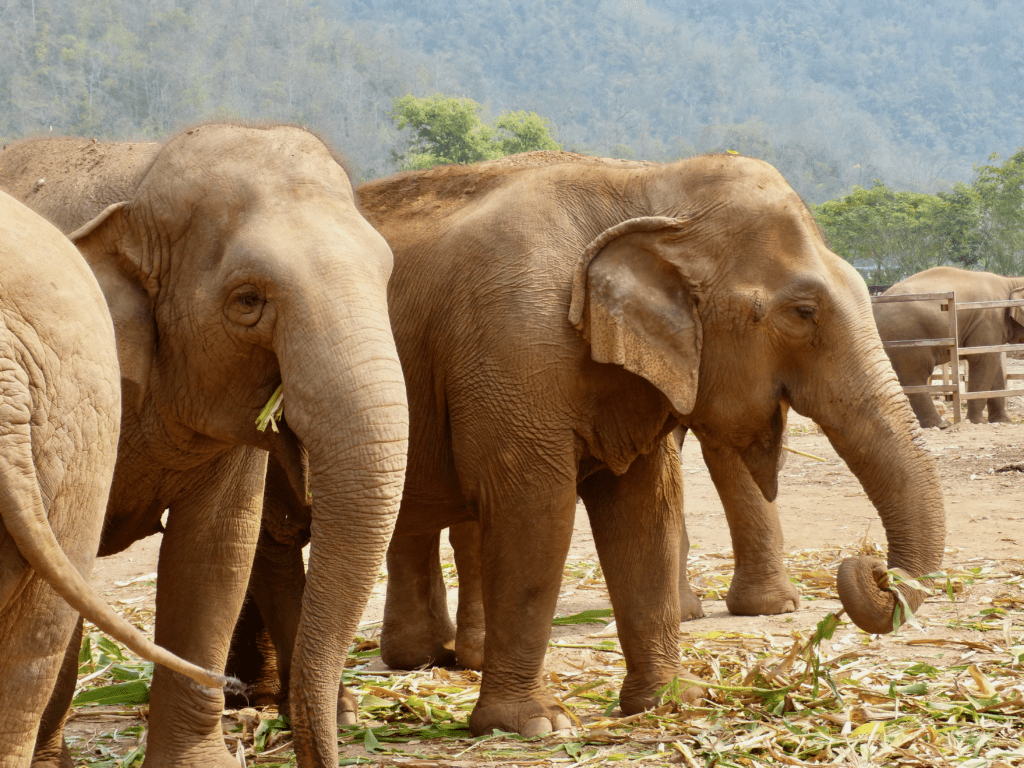


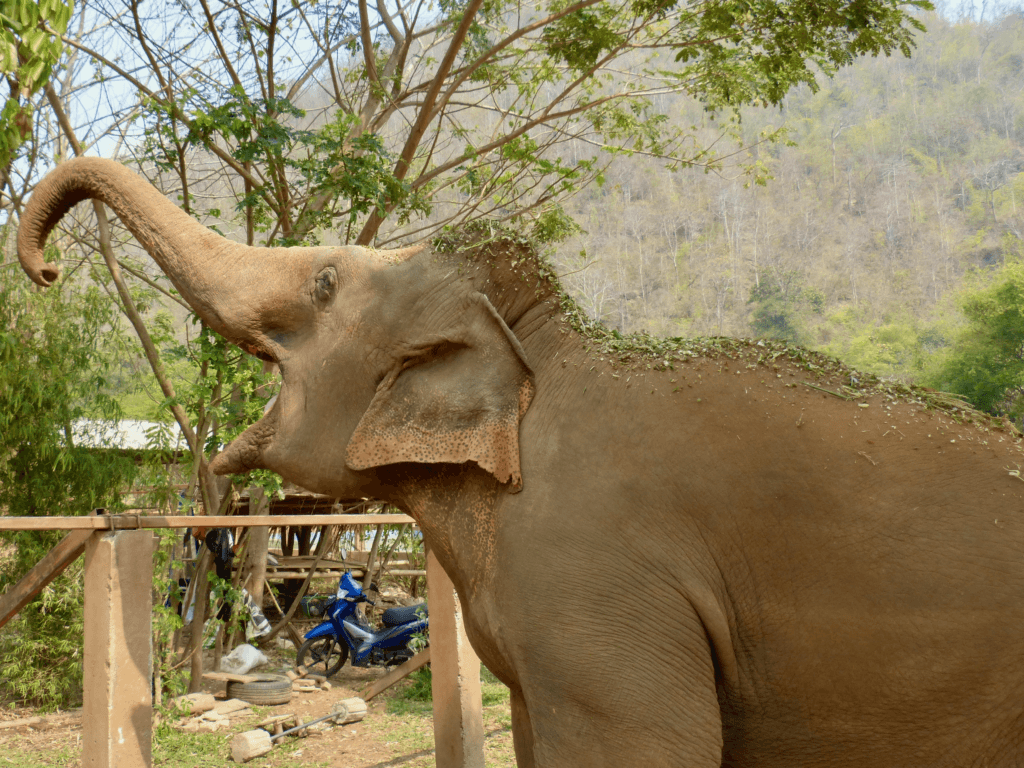

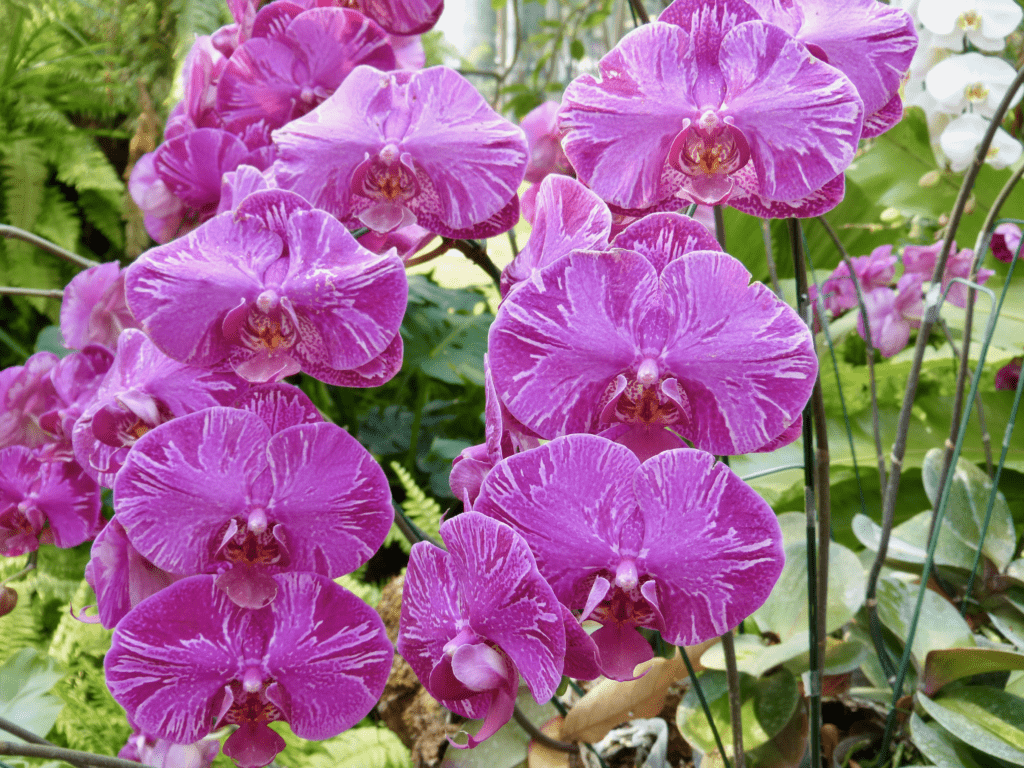


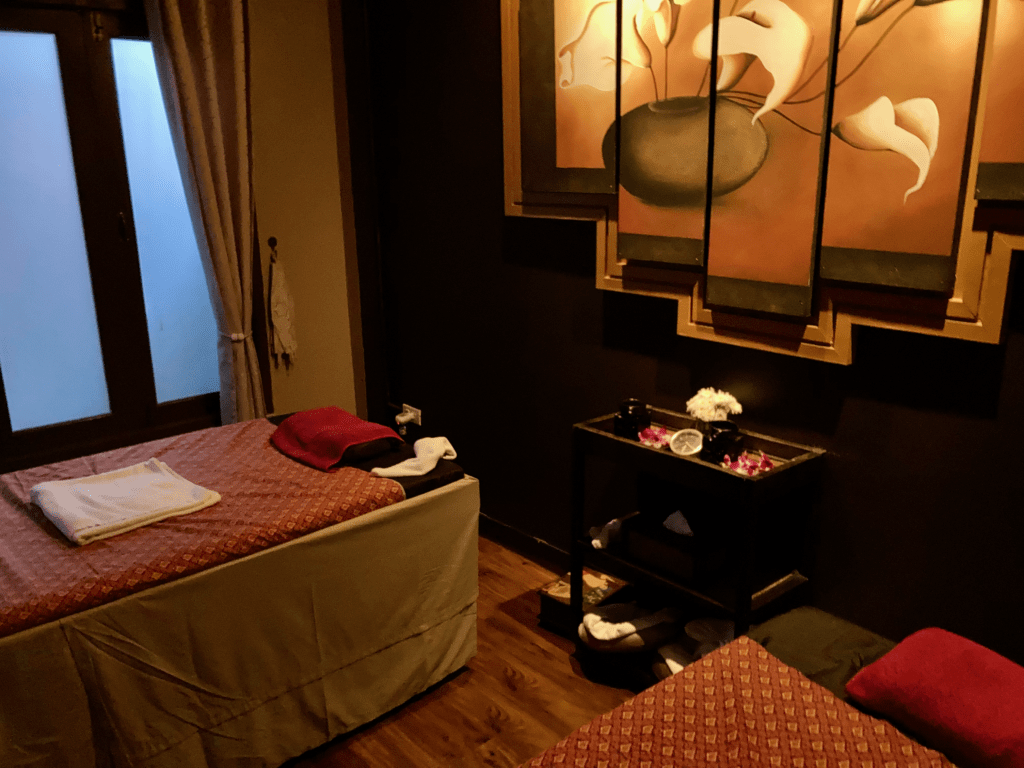






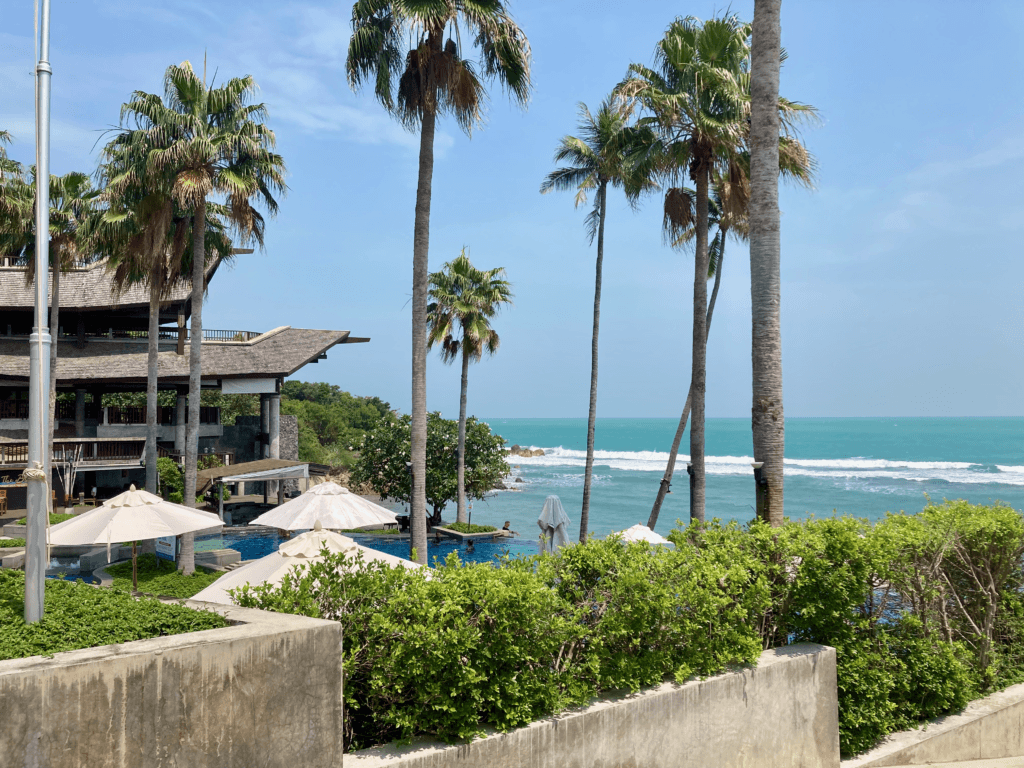

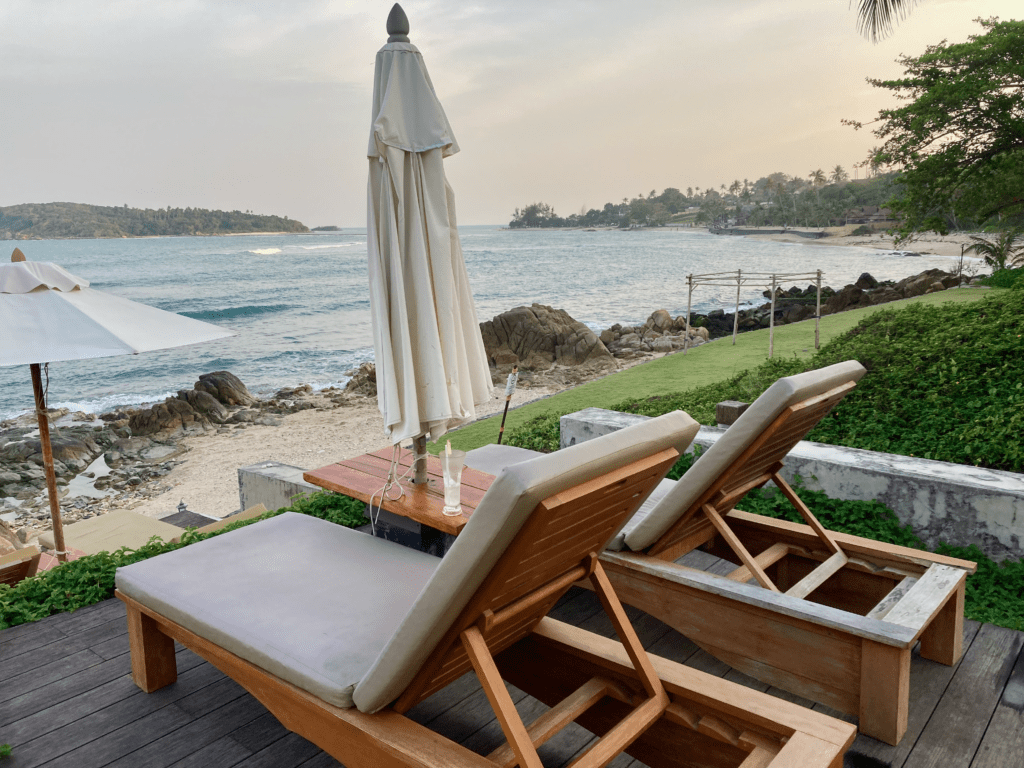


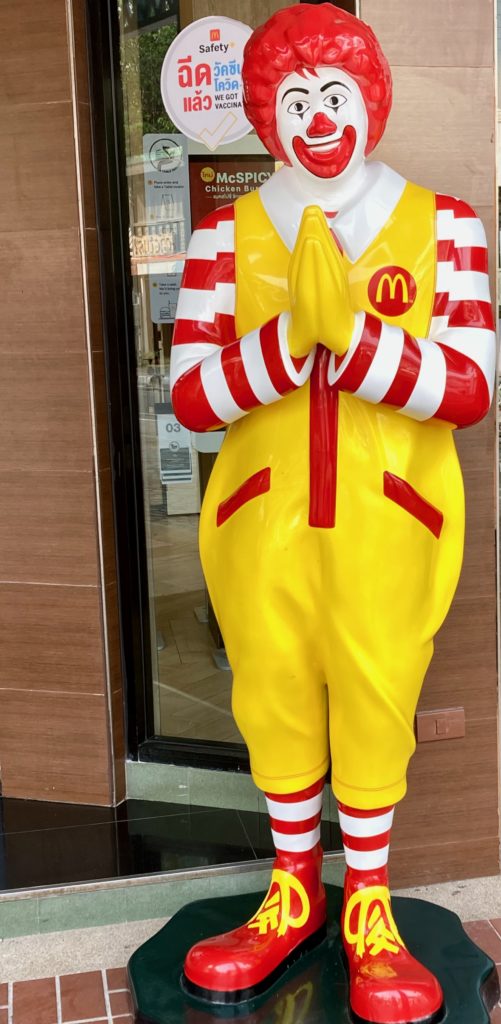
Such a wonderful and enlightening narrative. How fortunate you are to be able to travel to such exotic parts of the world. Thanks for sharing.